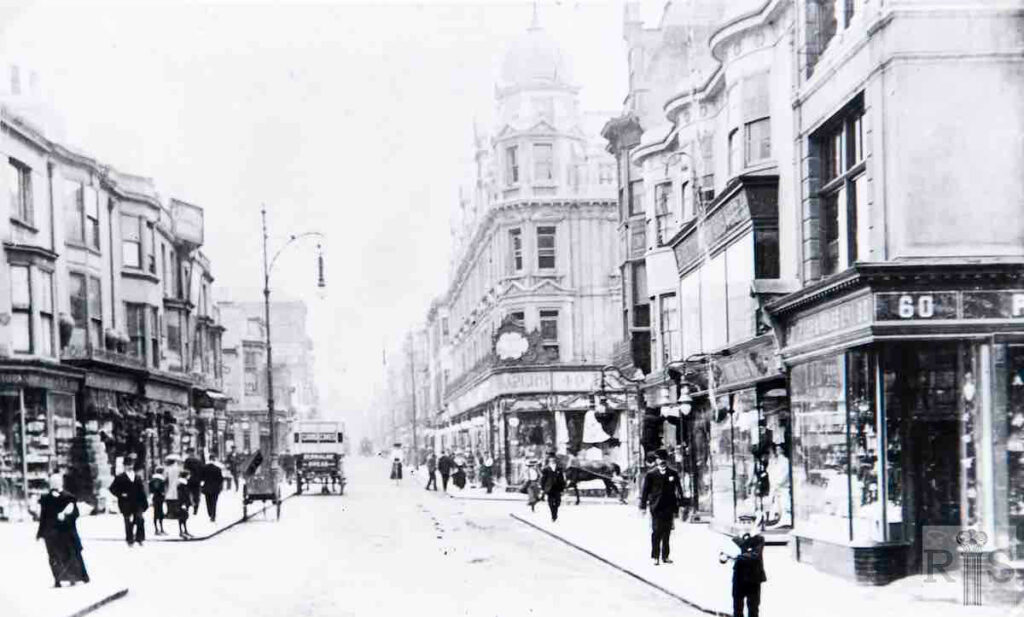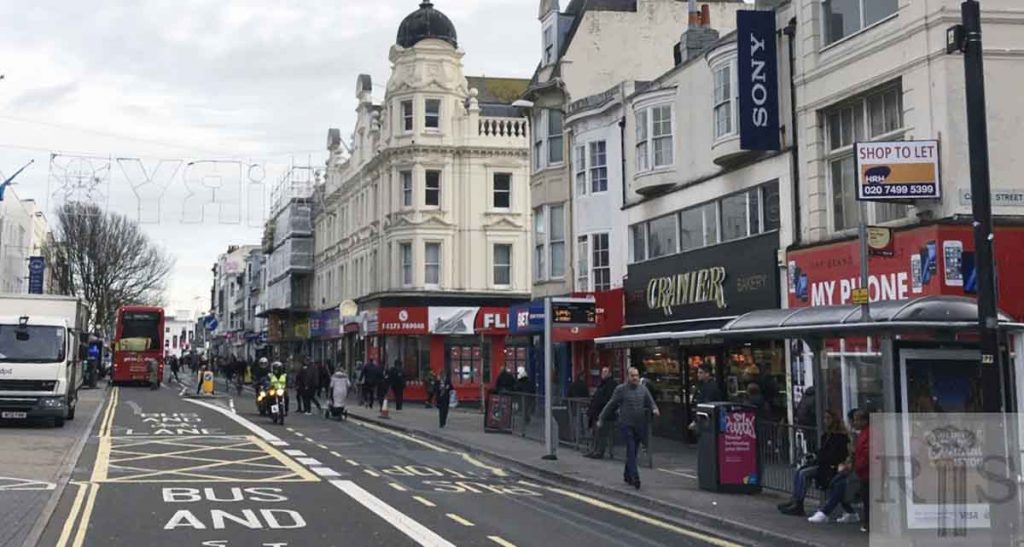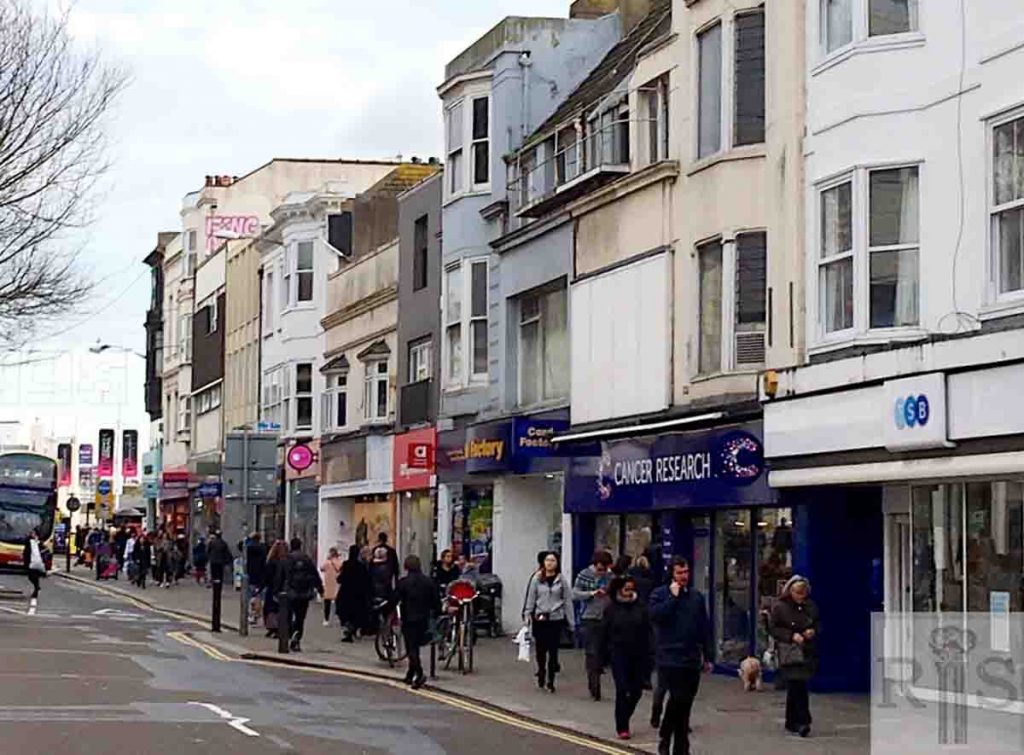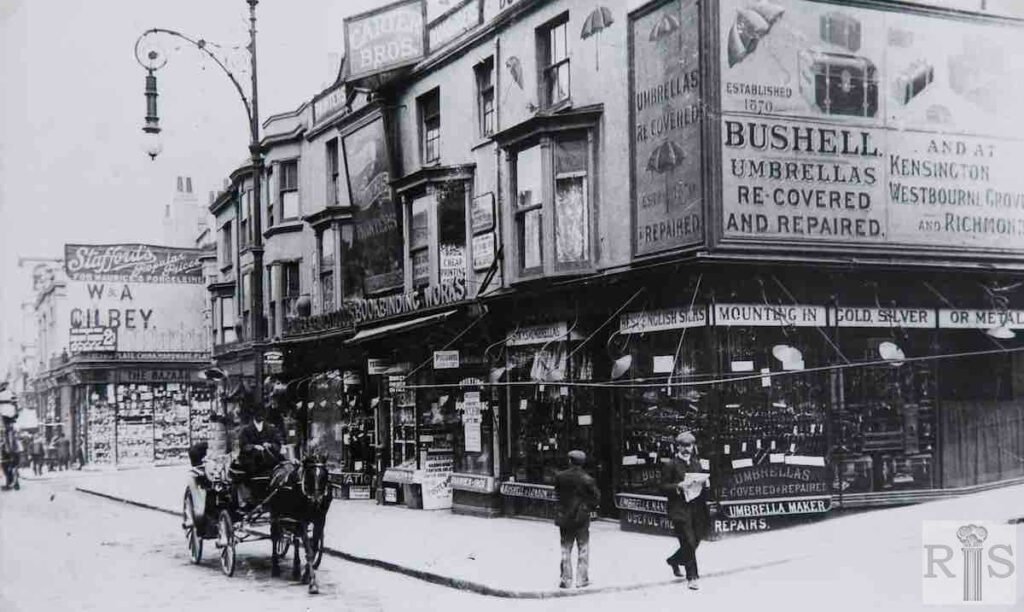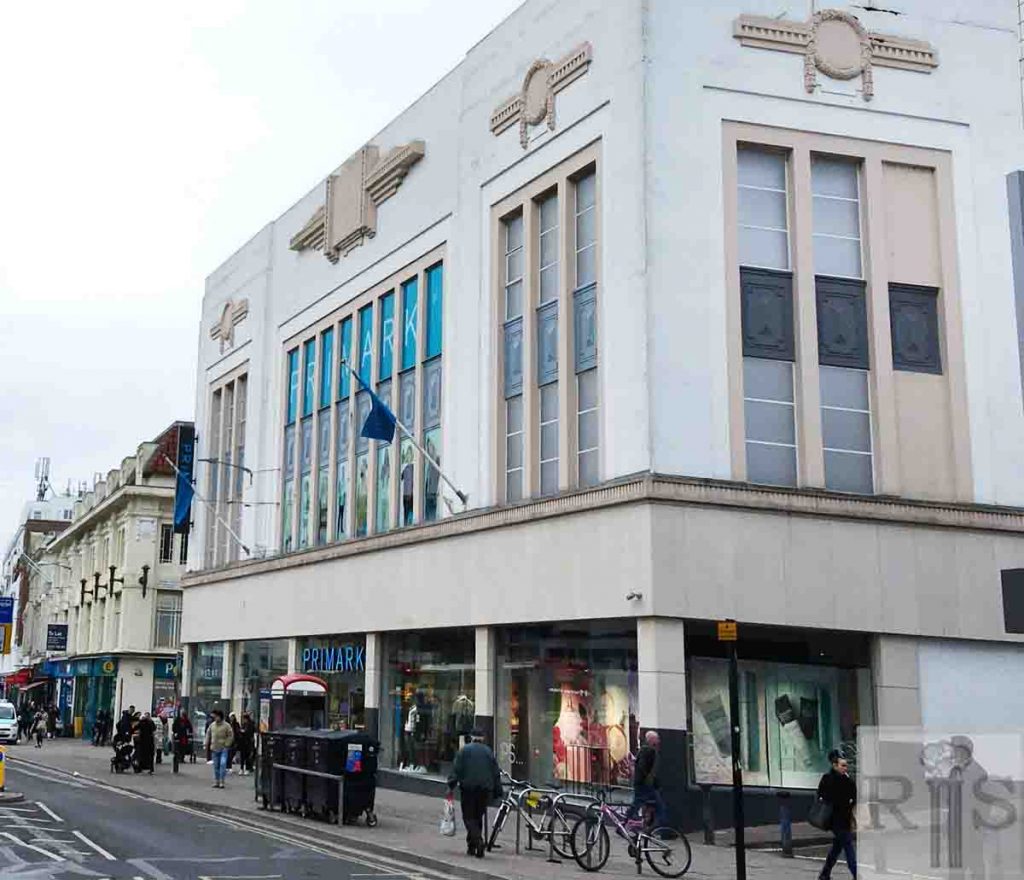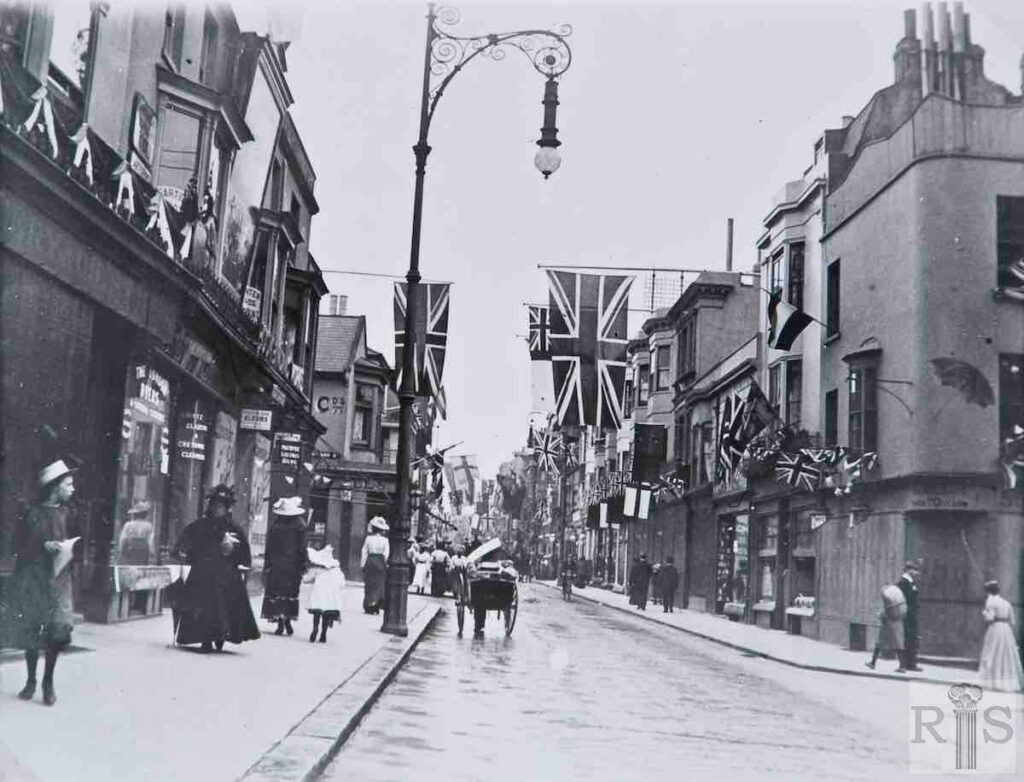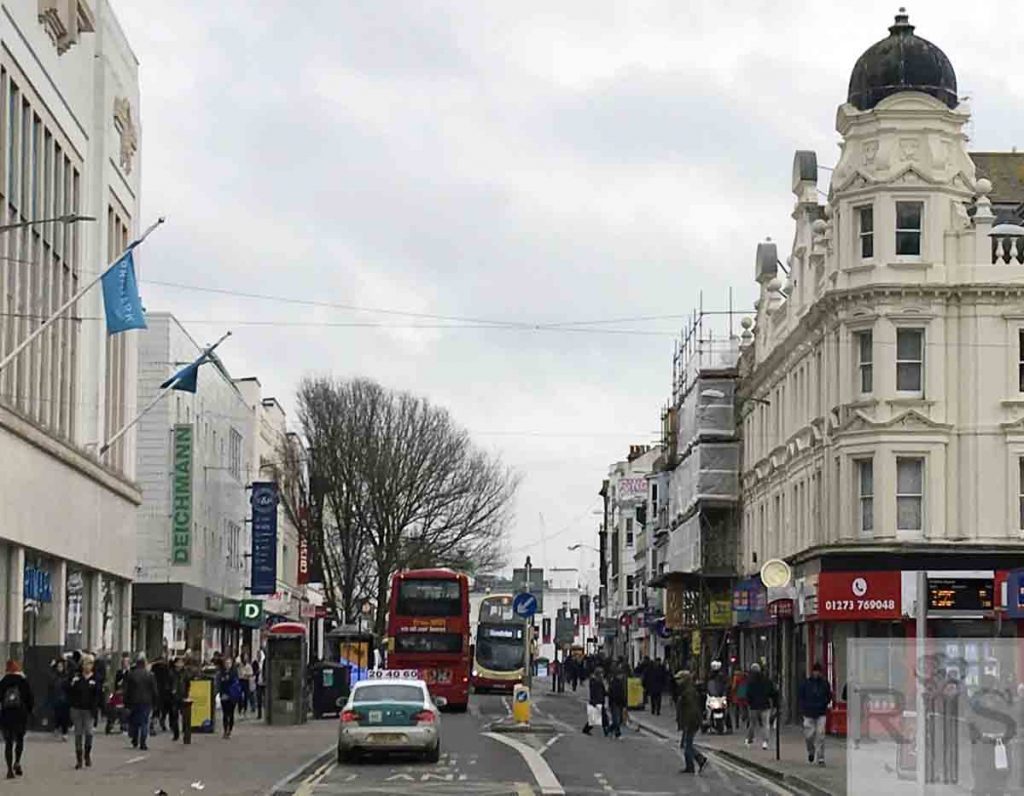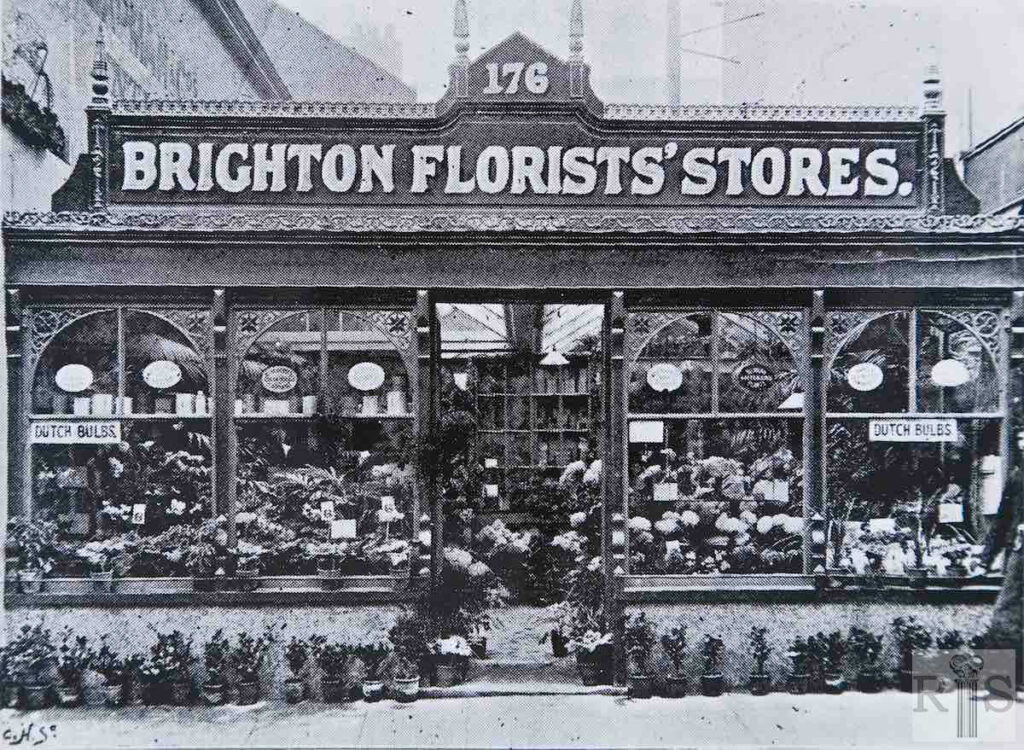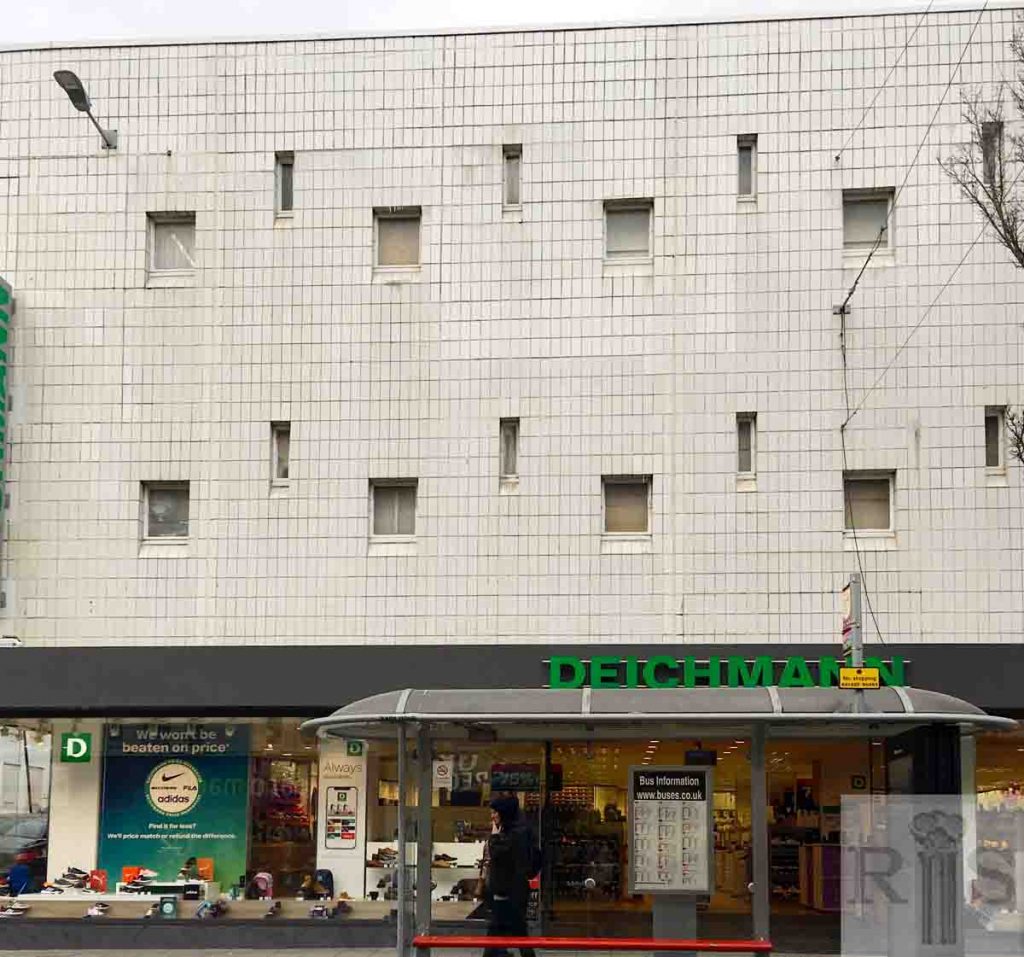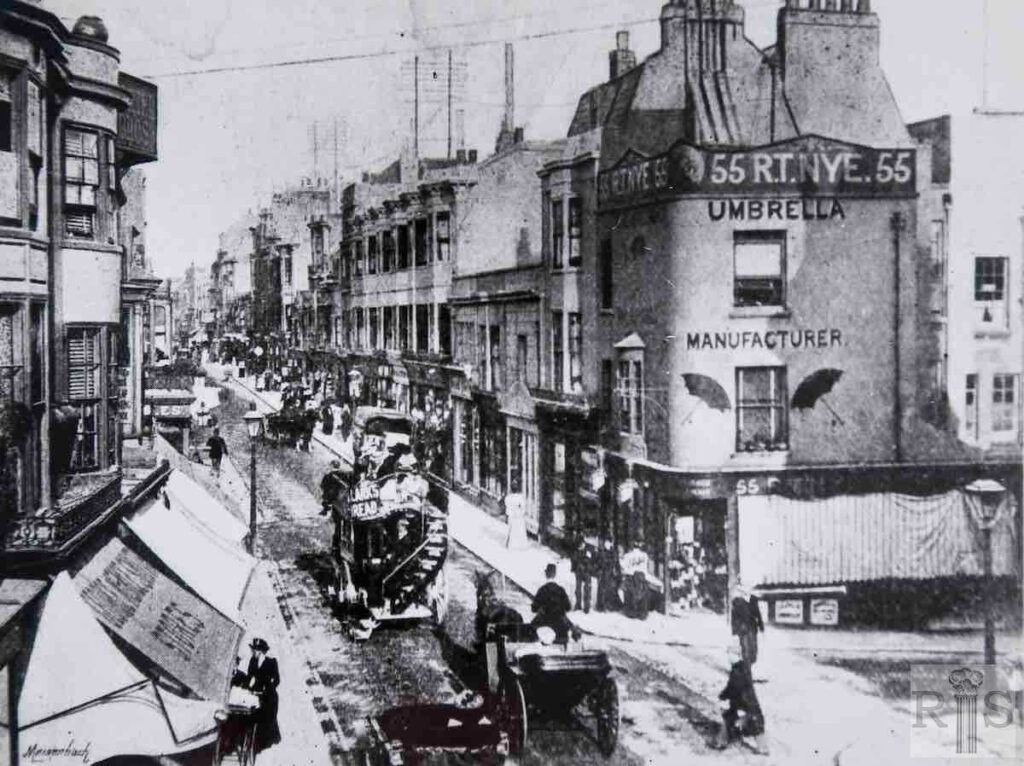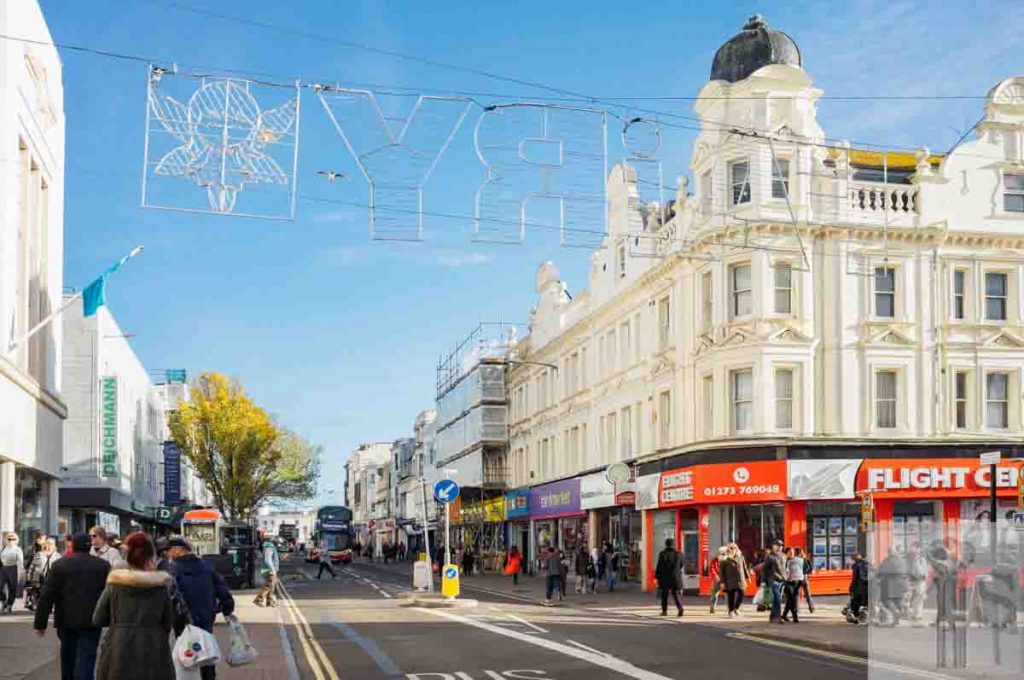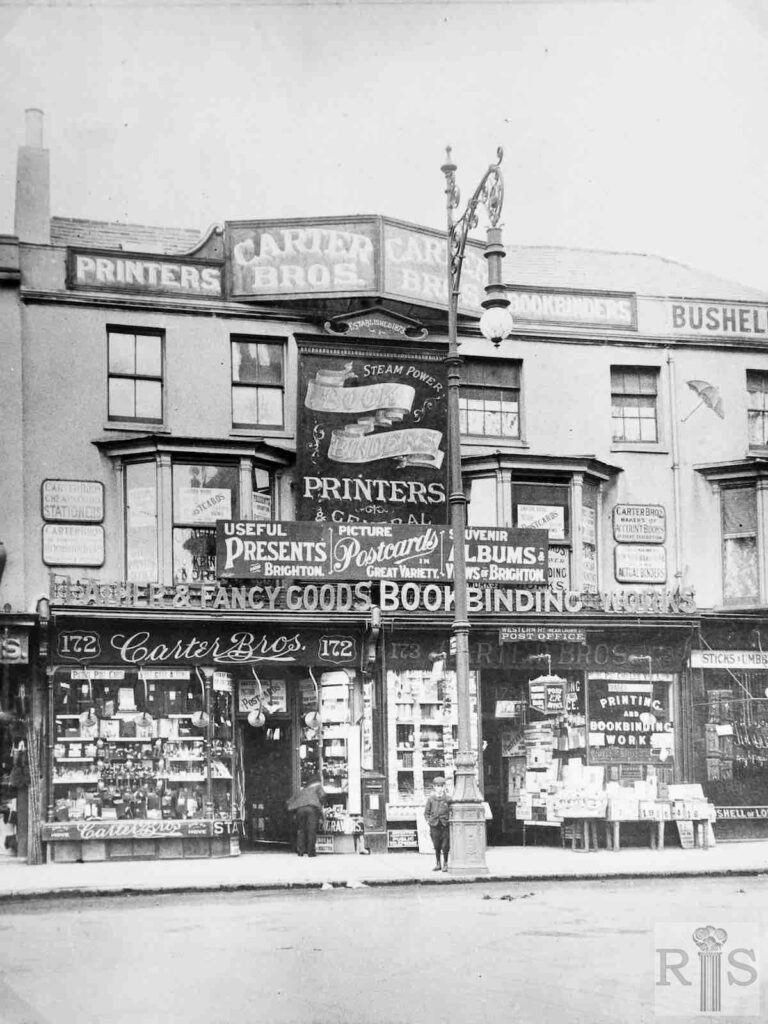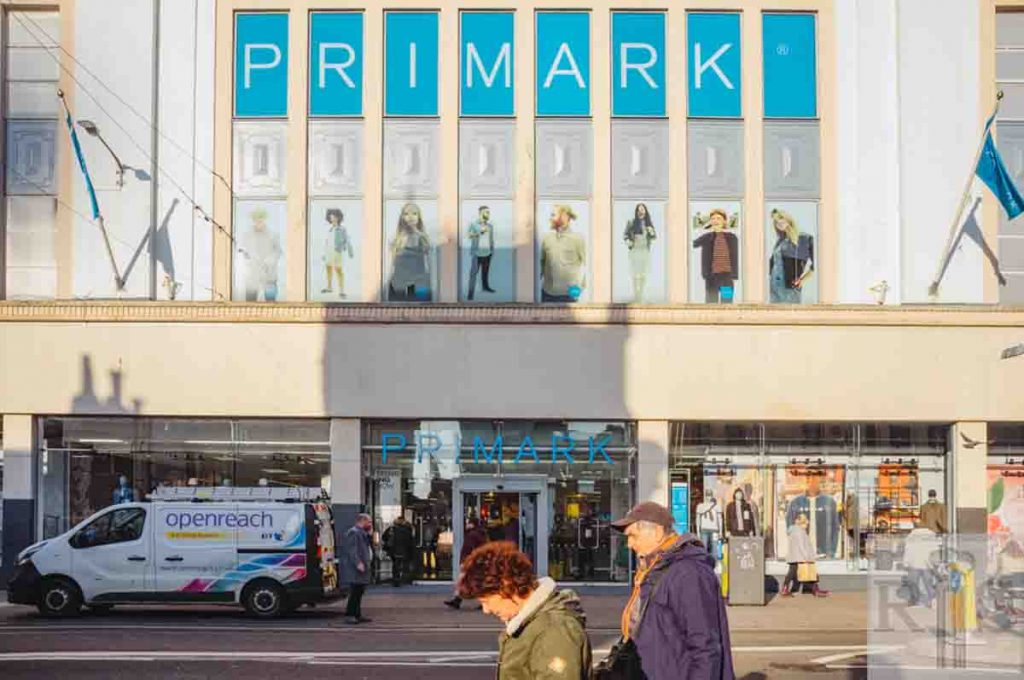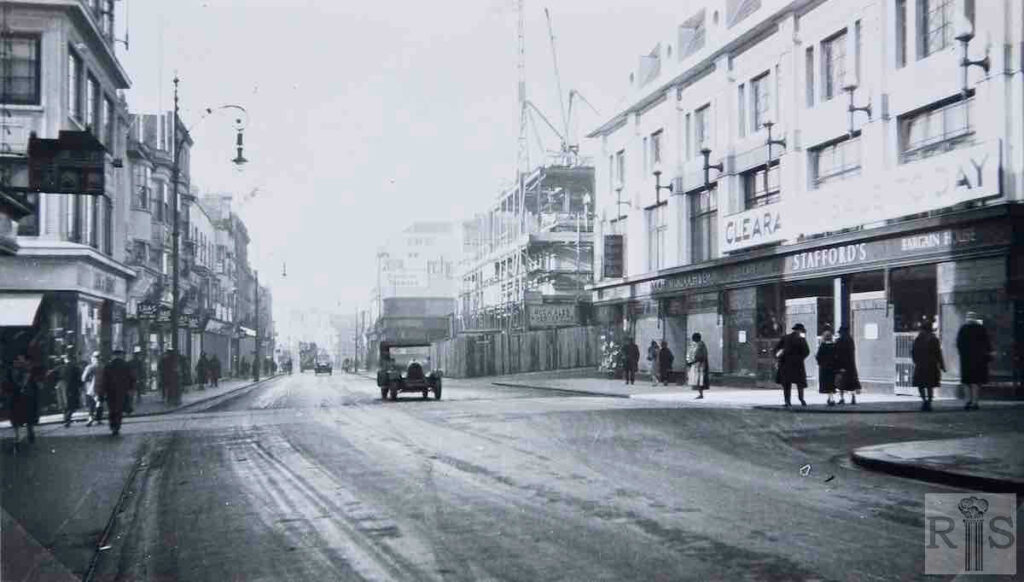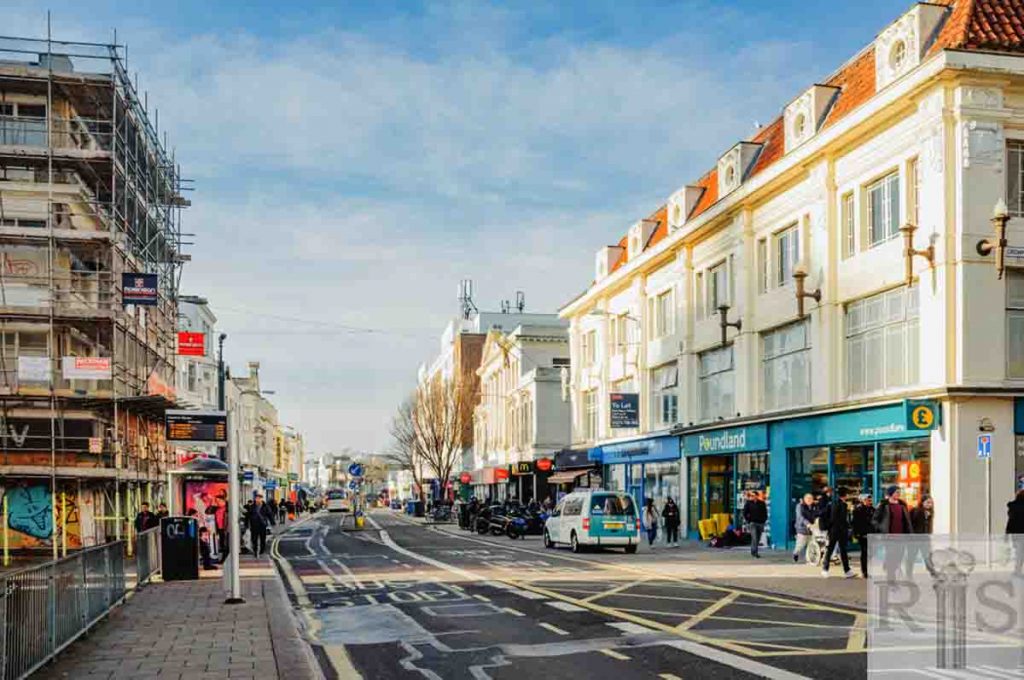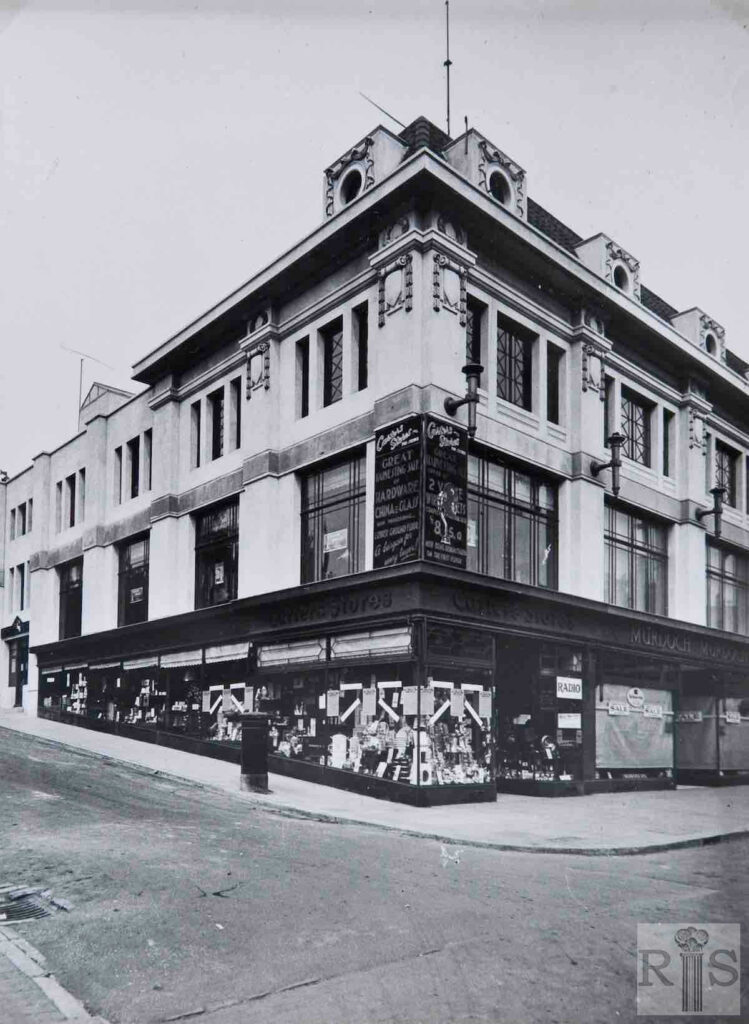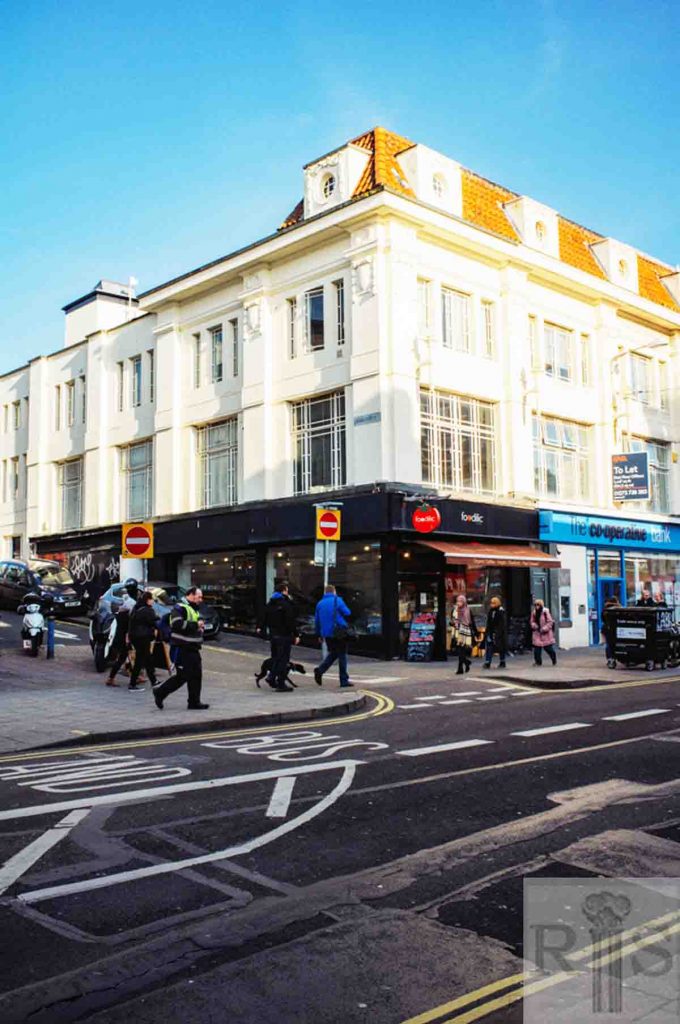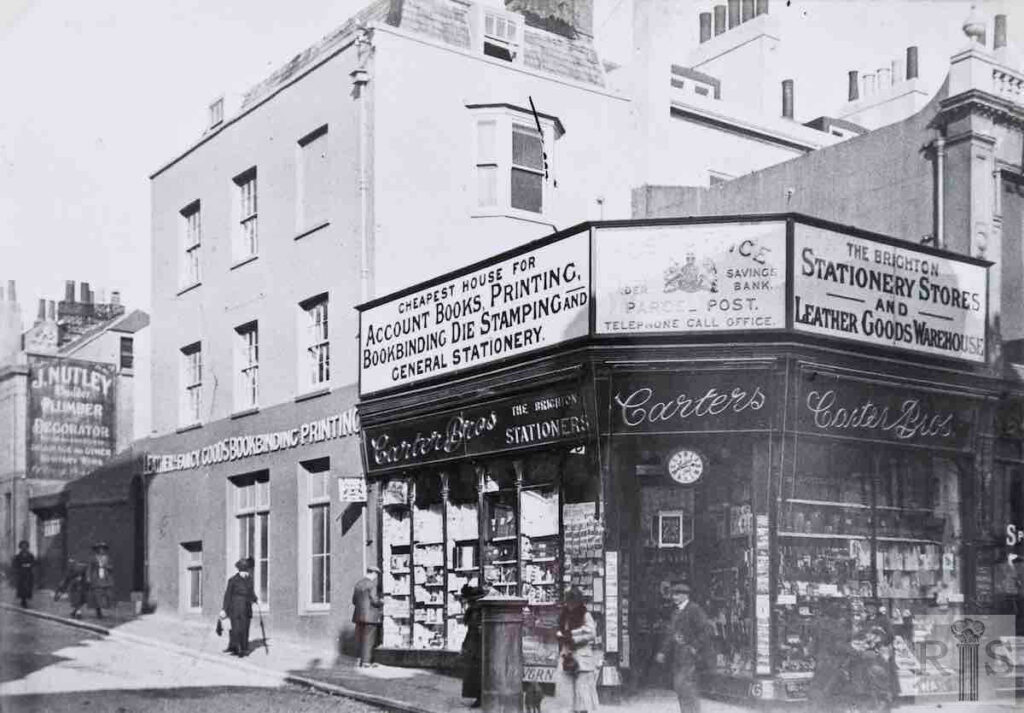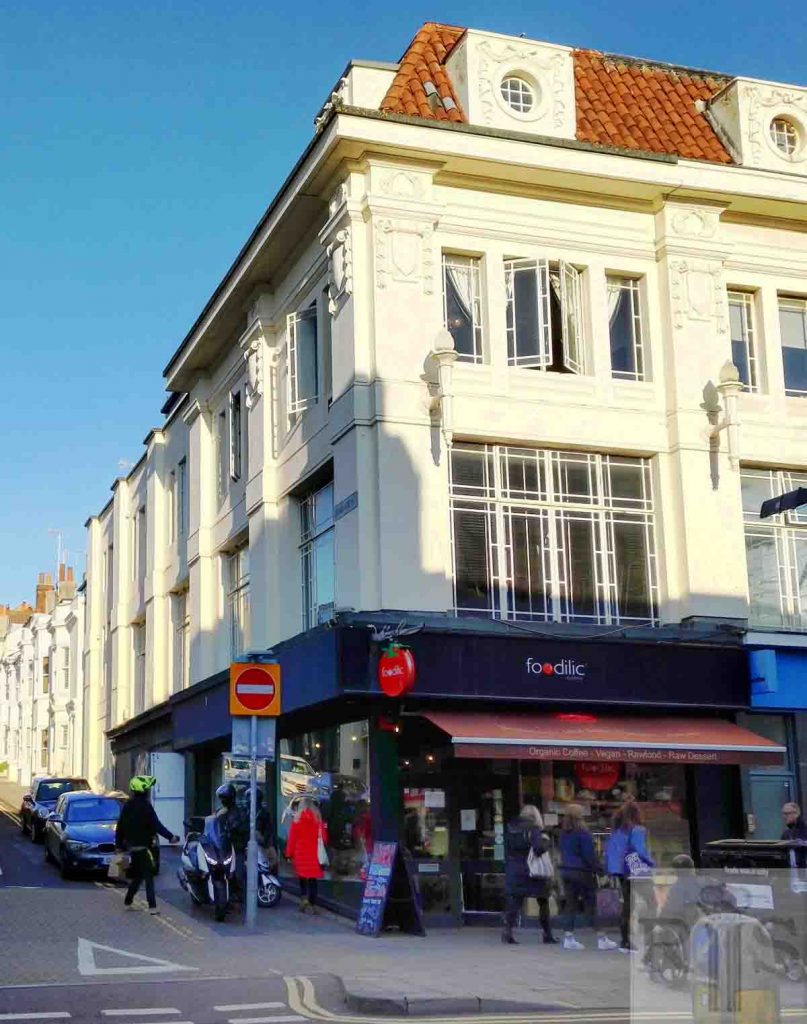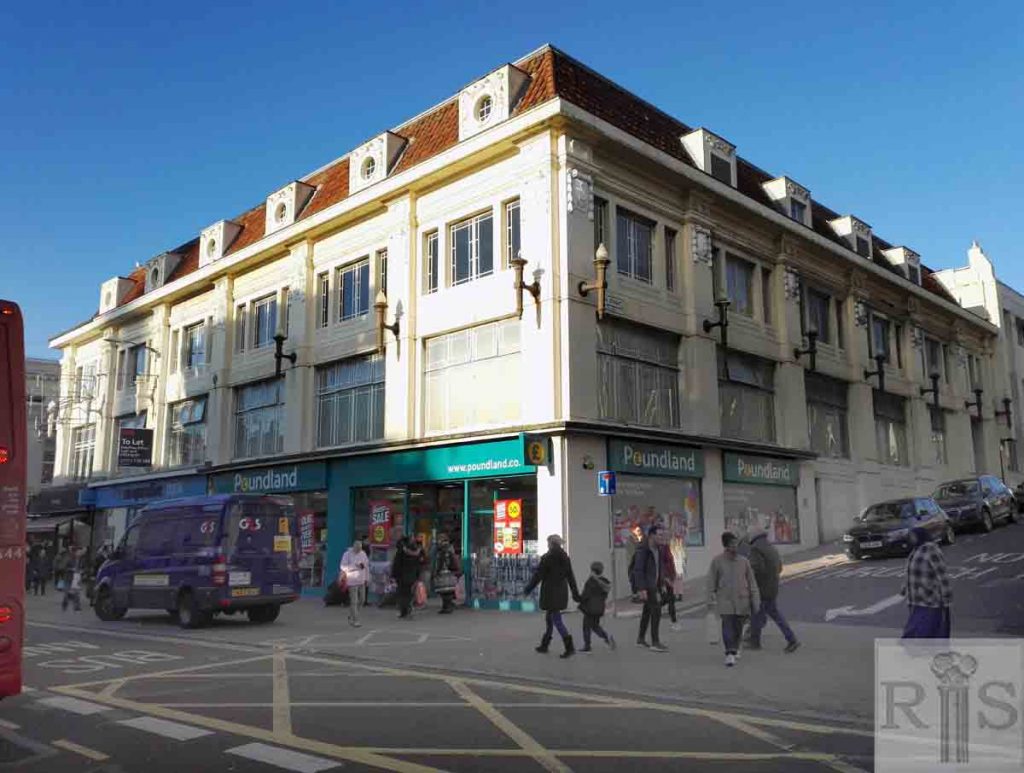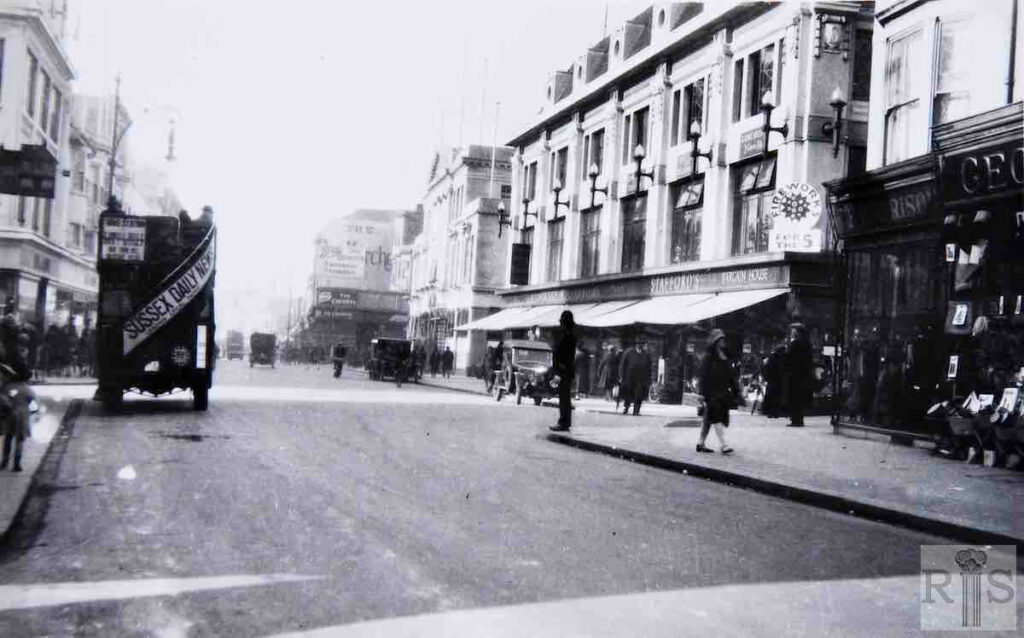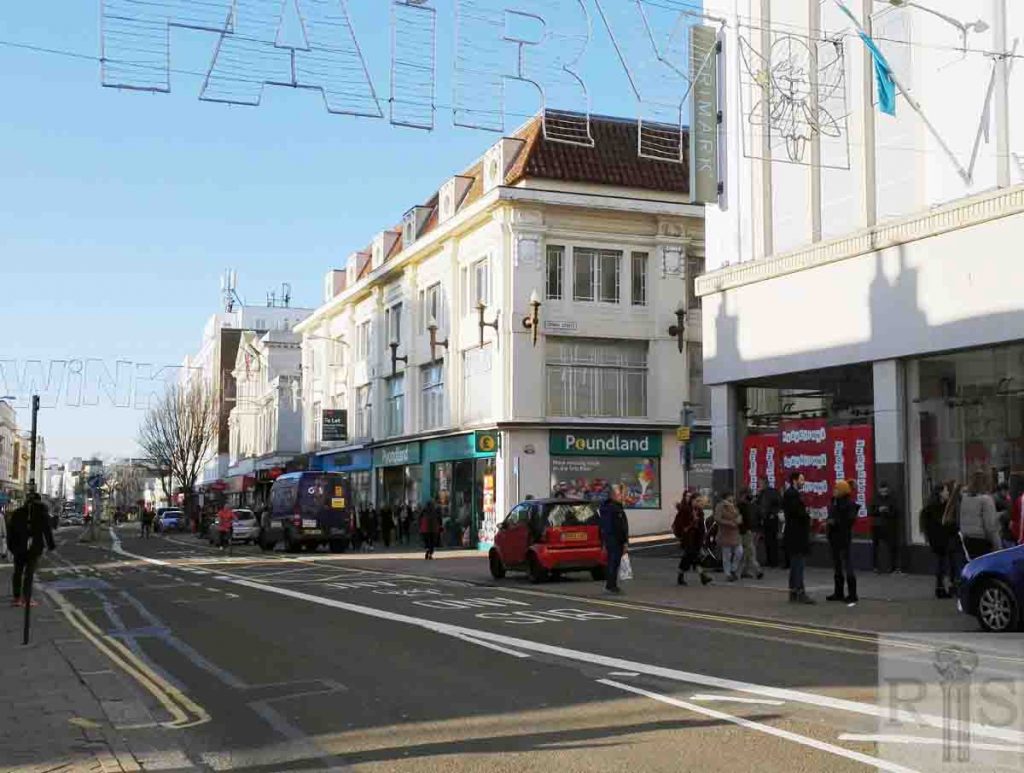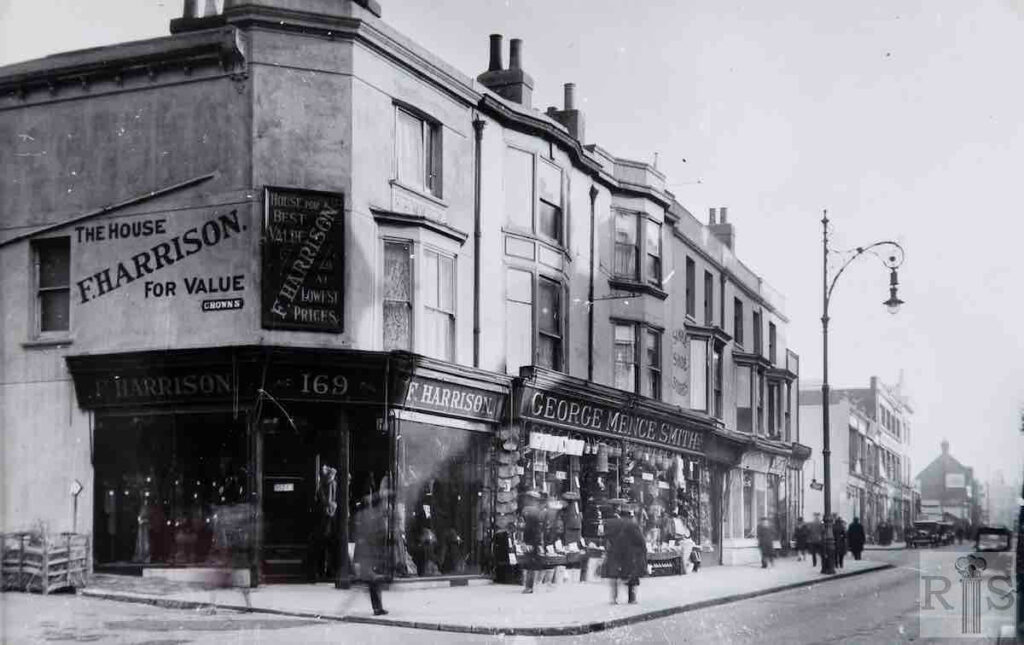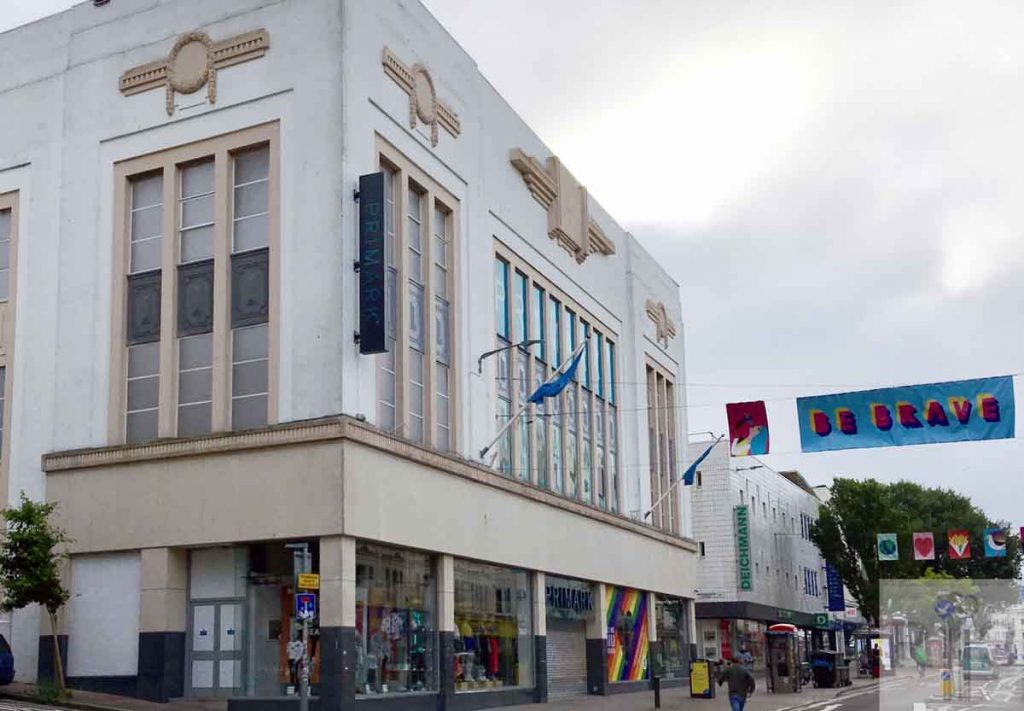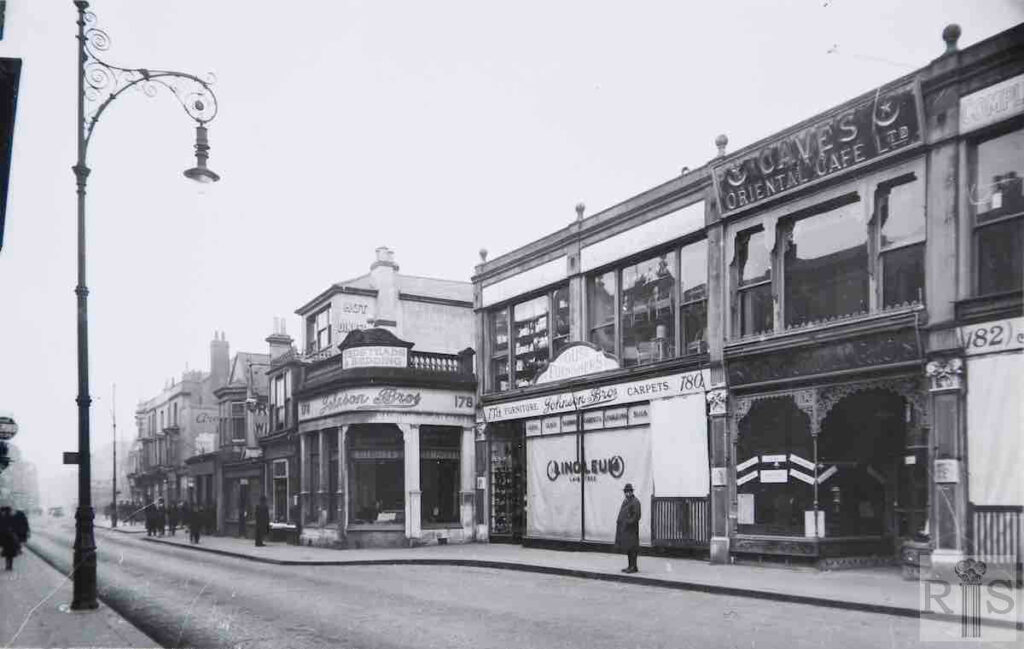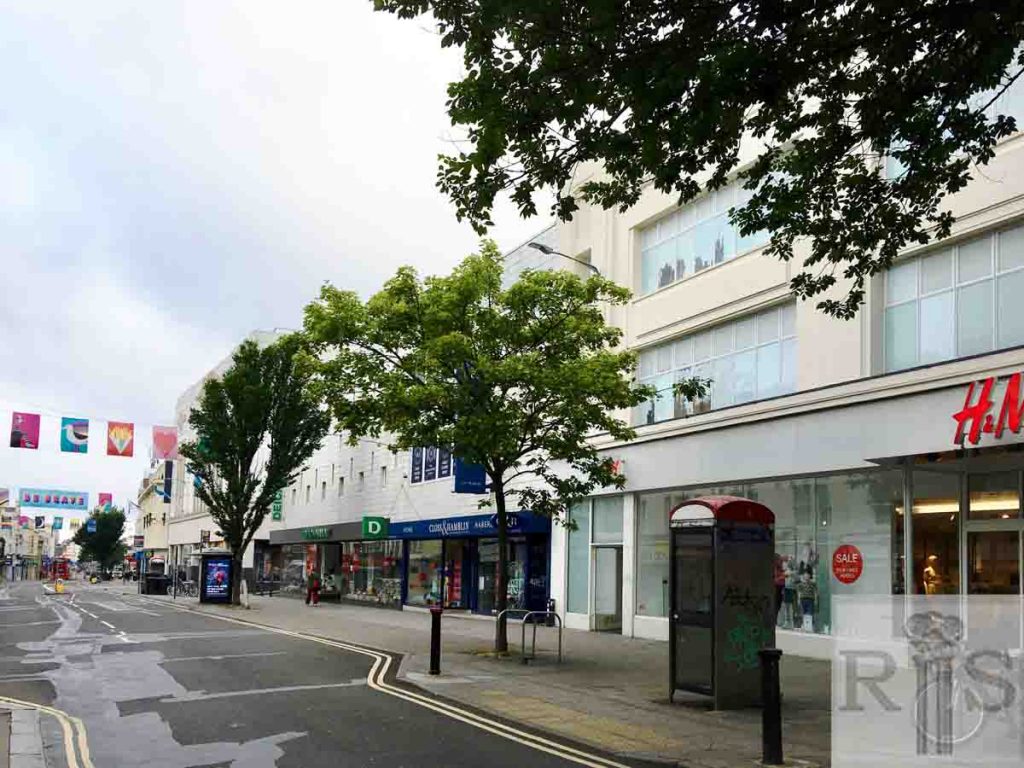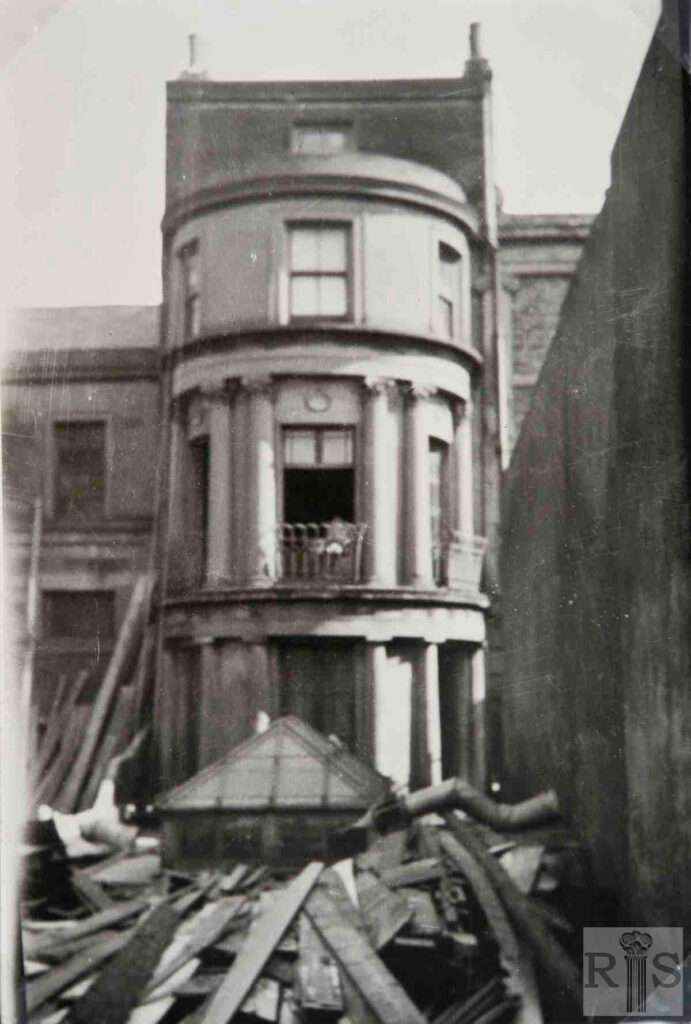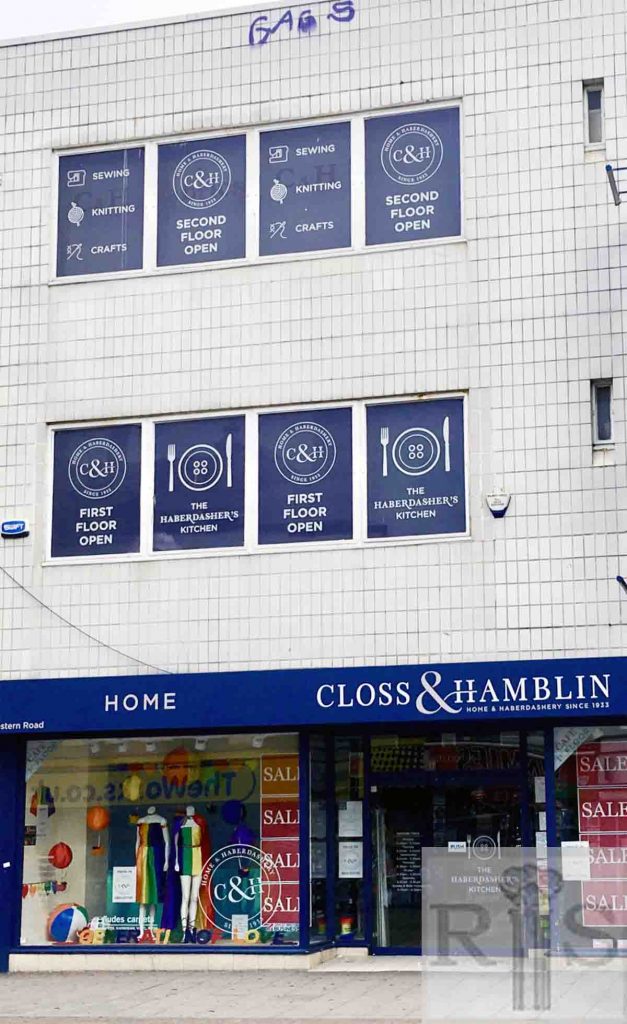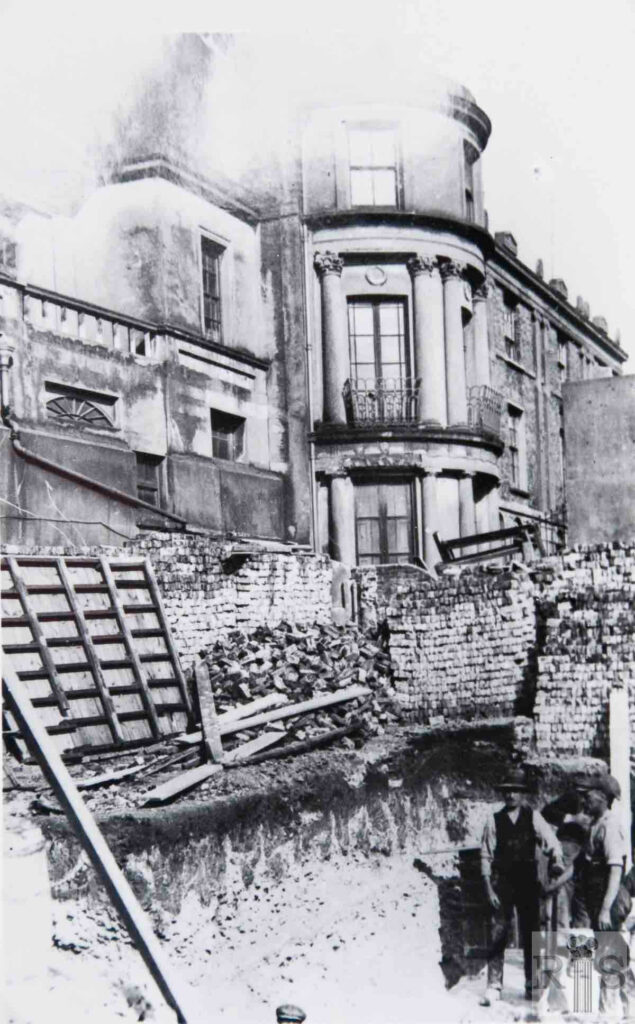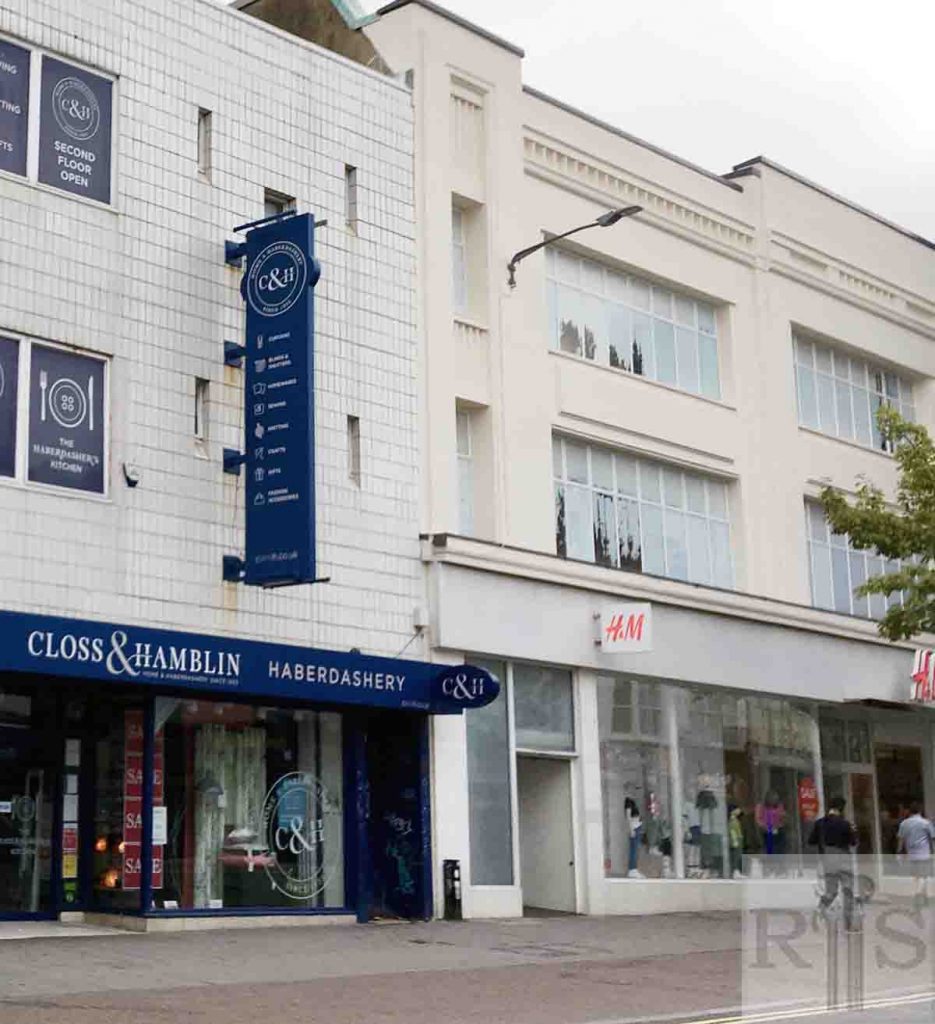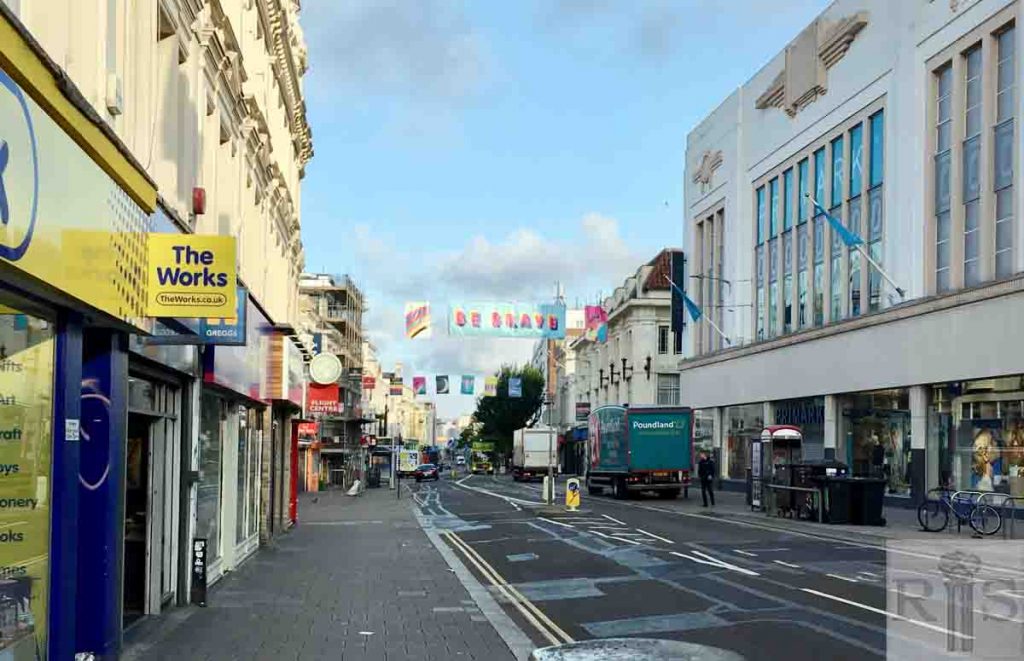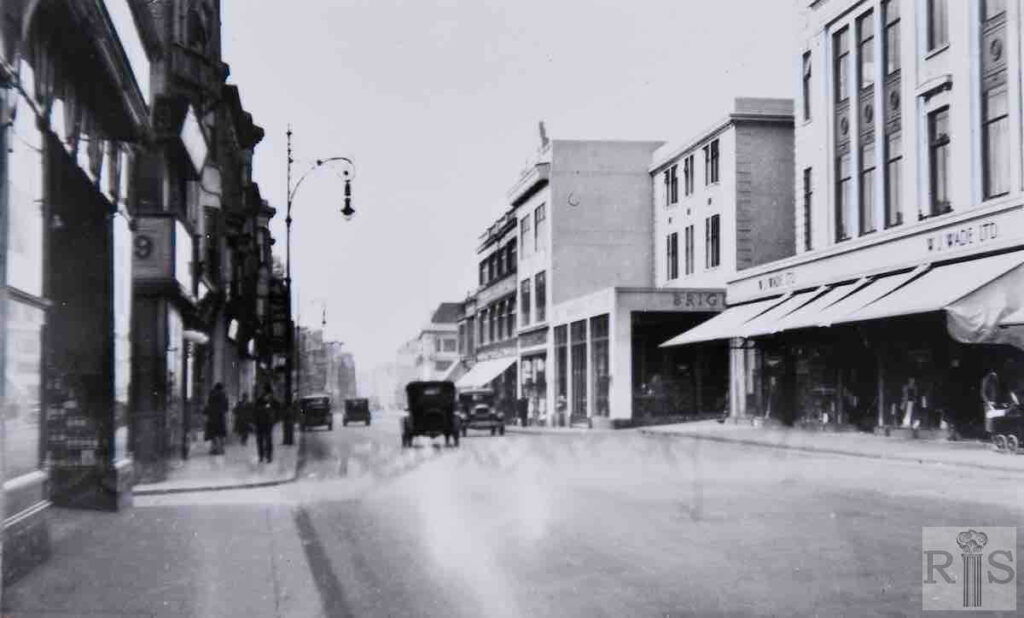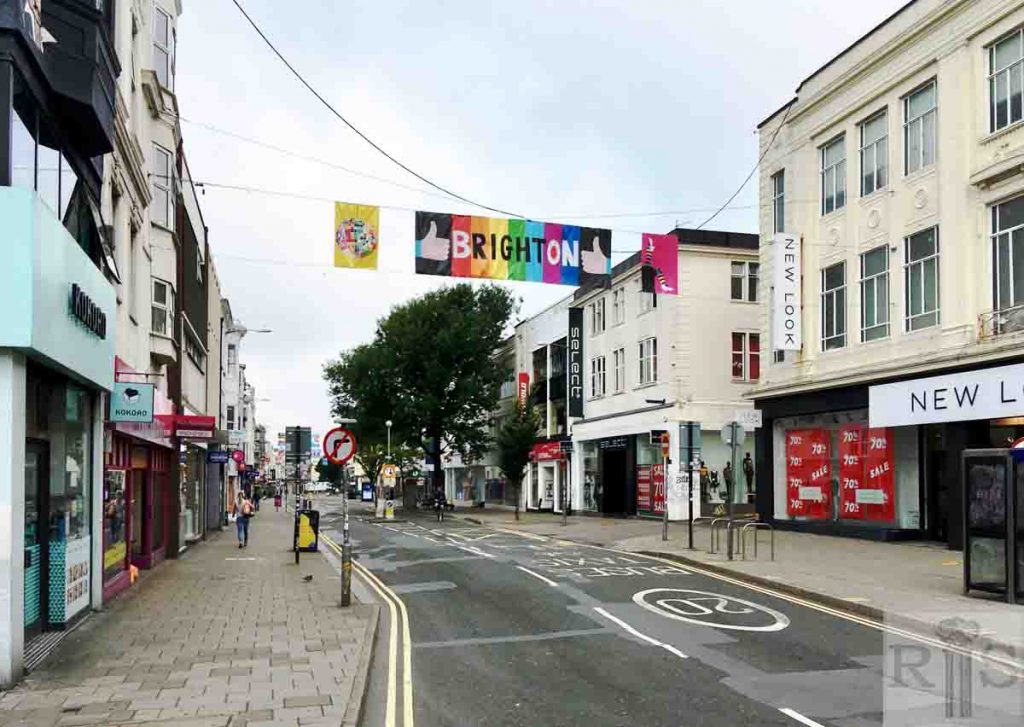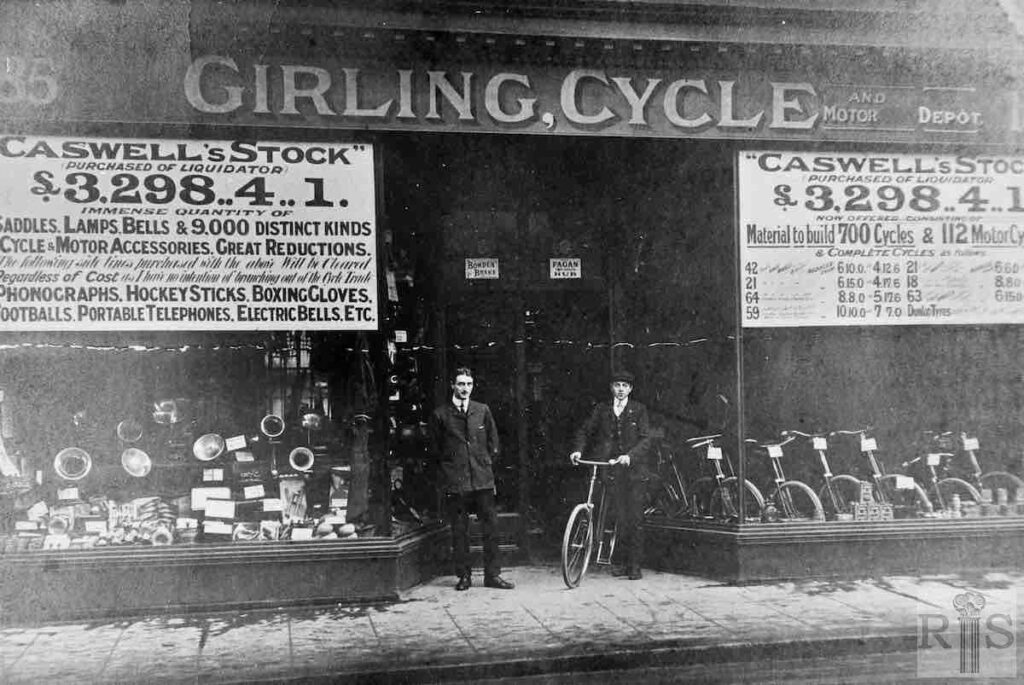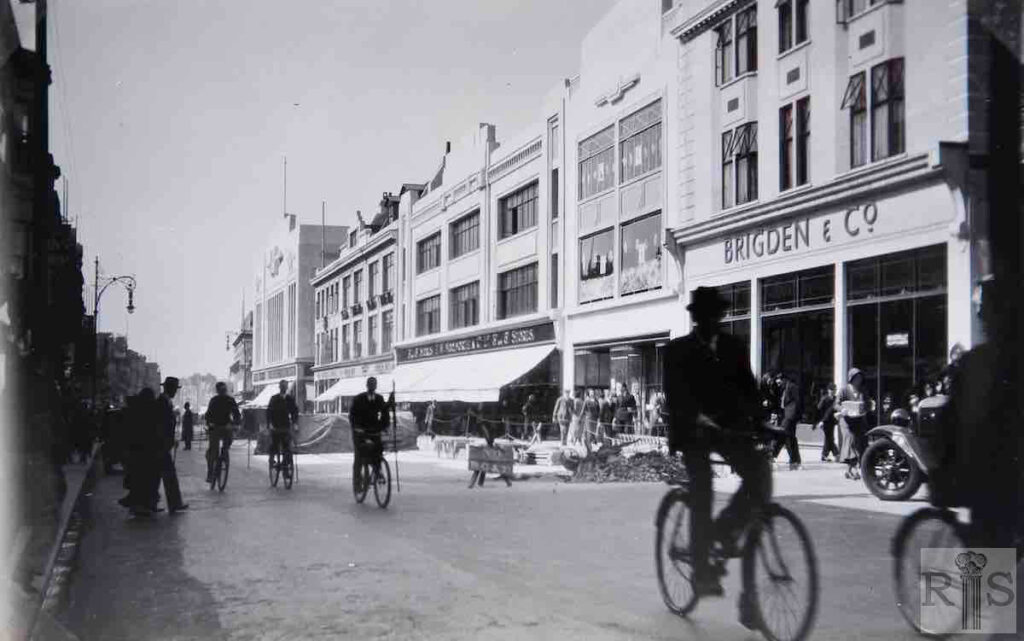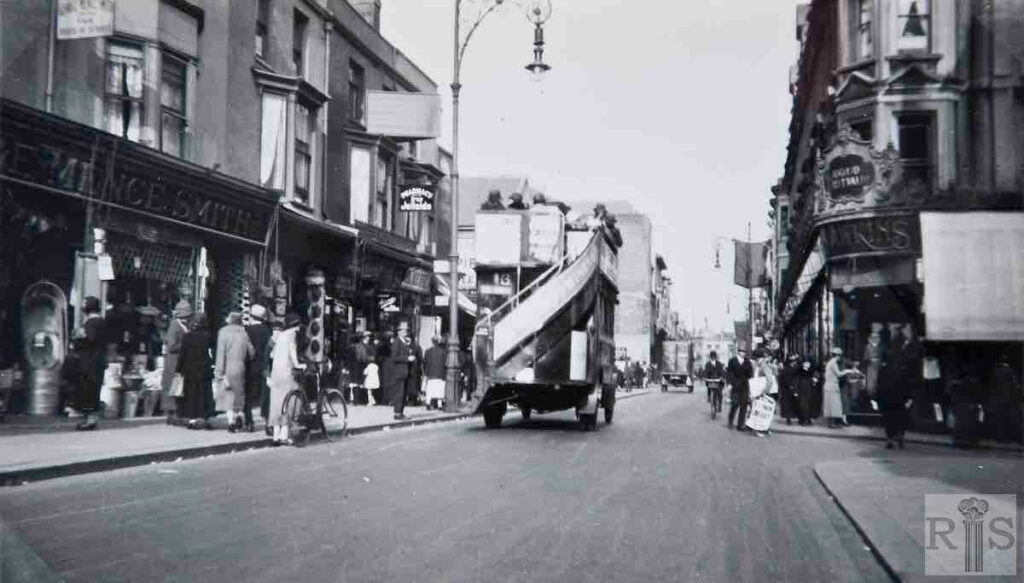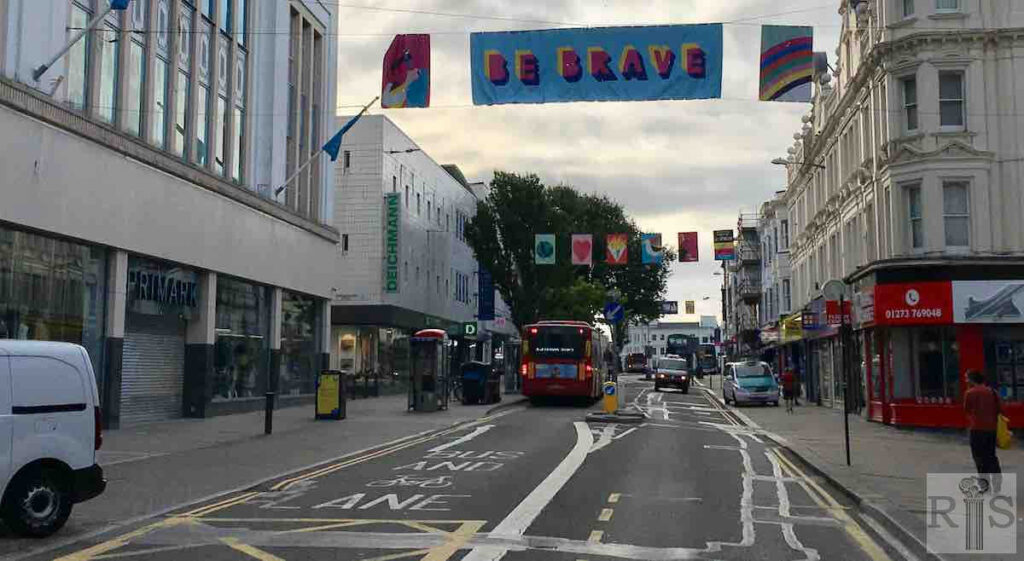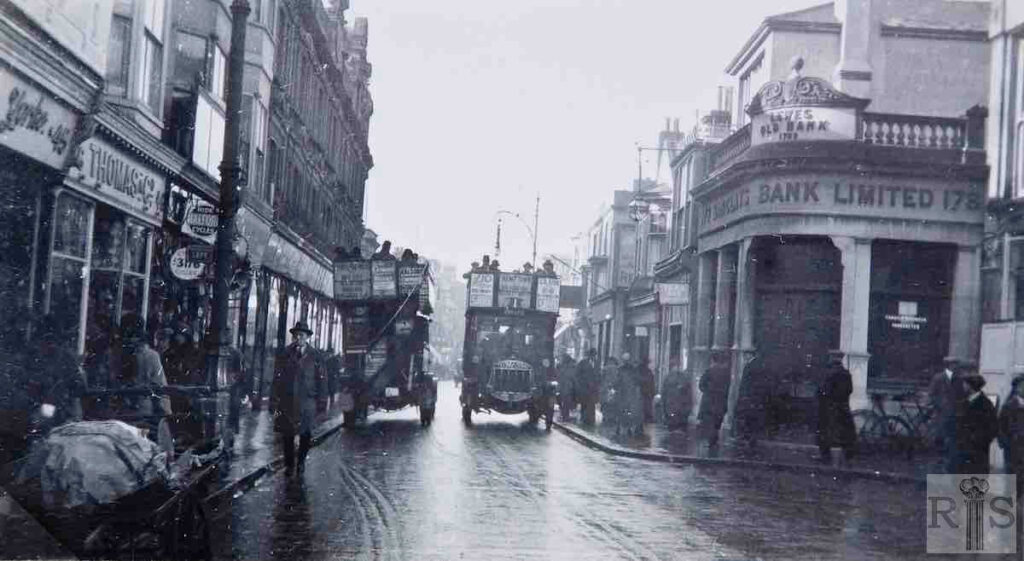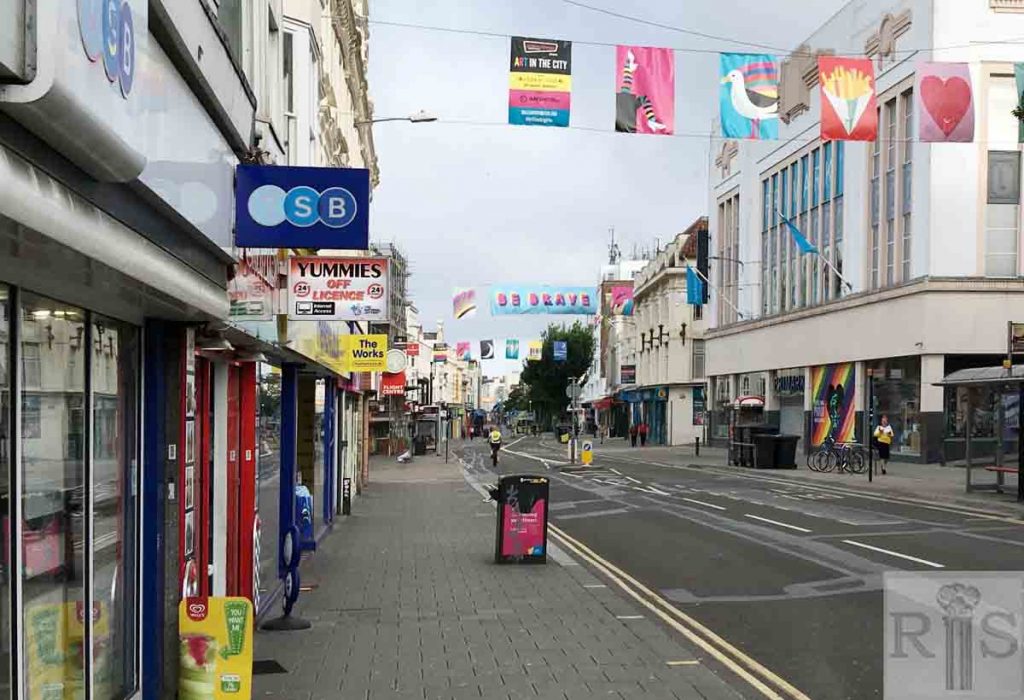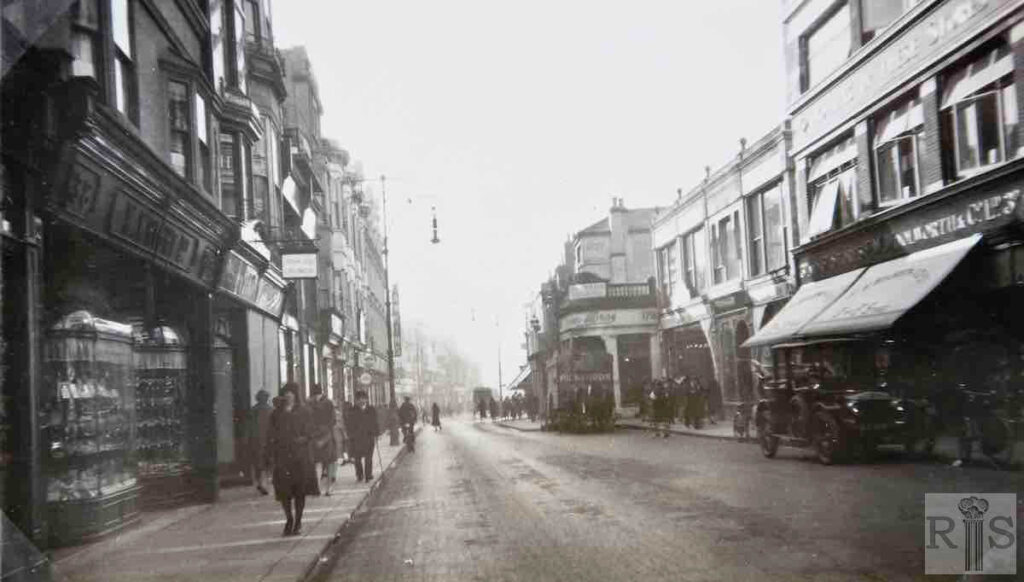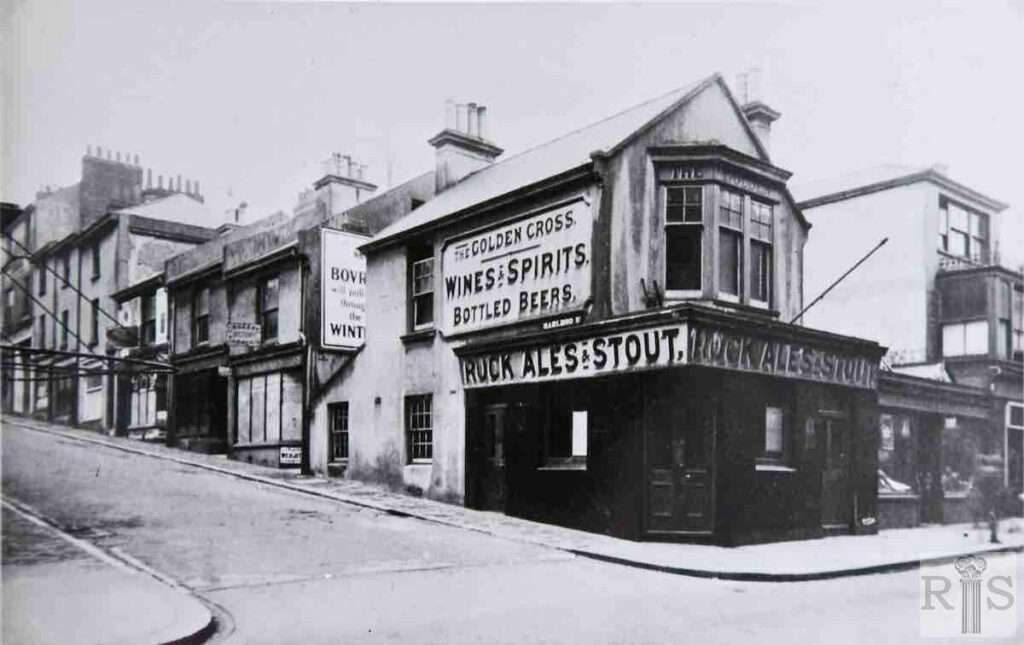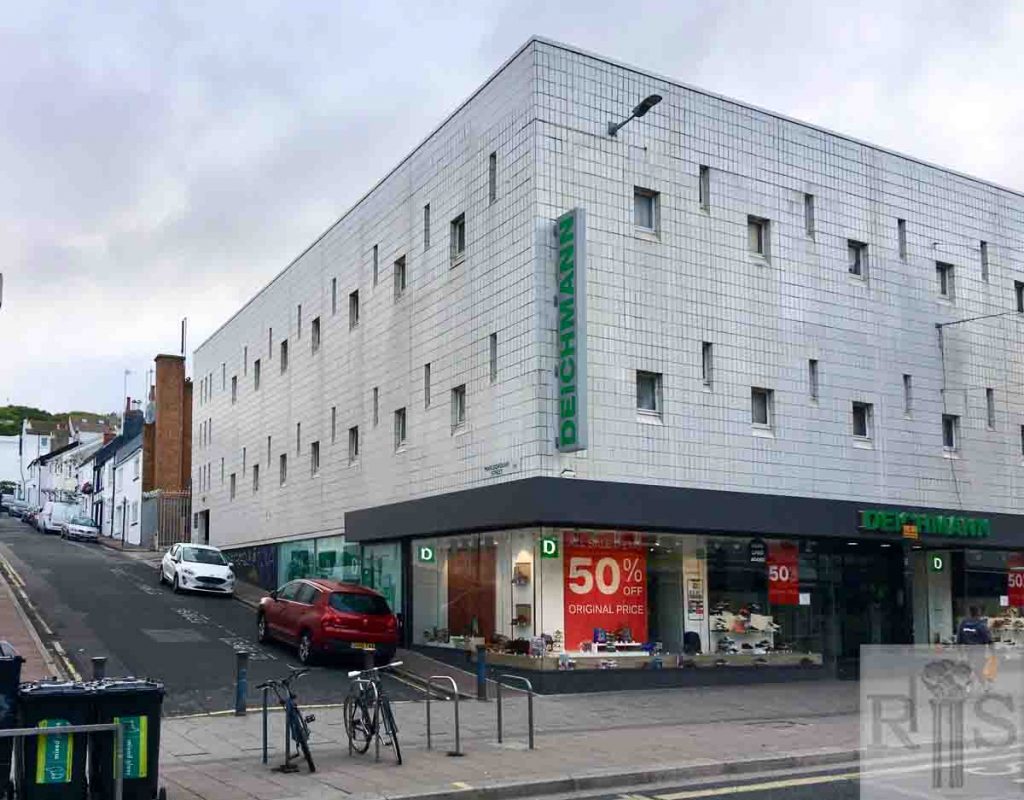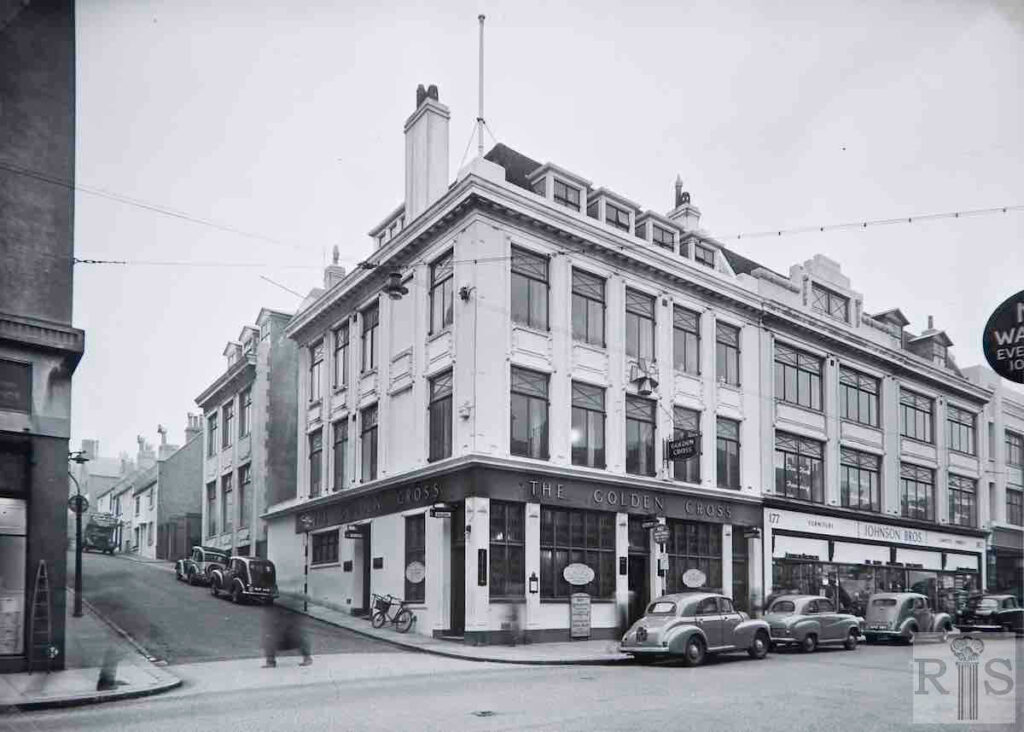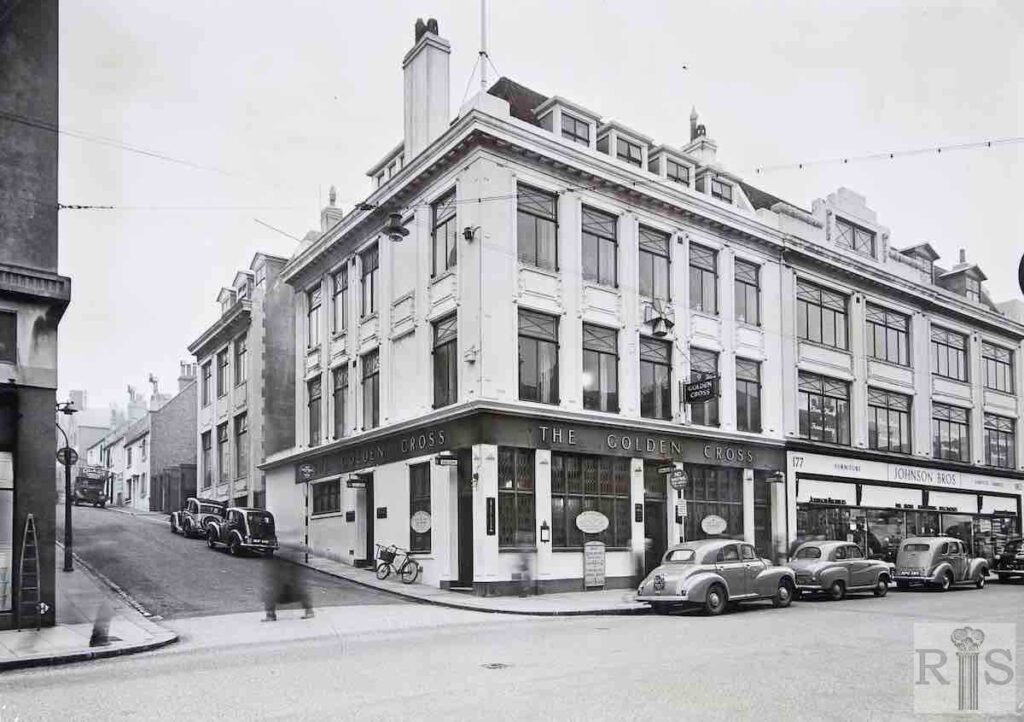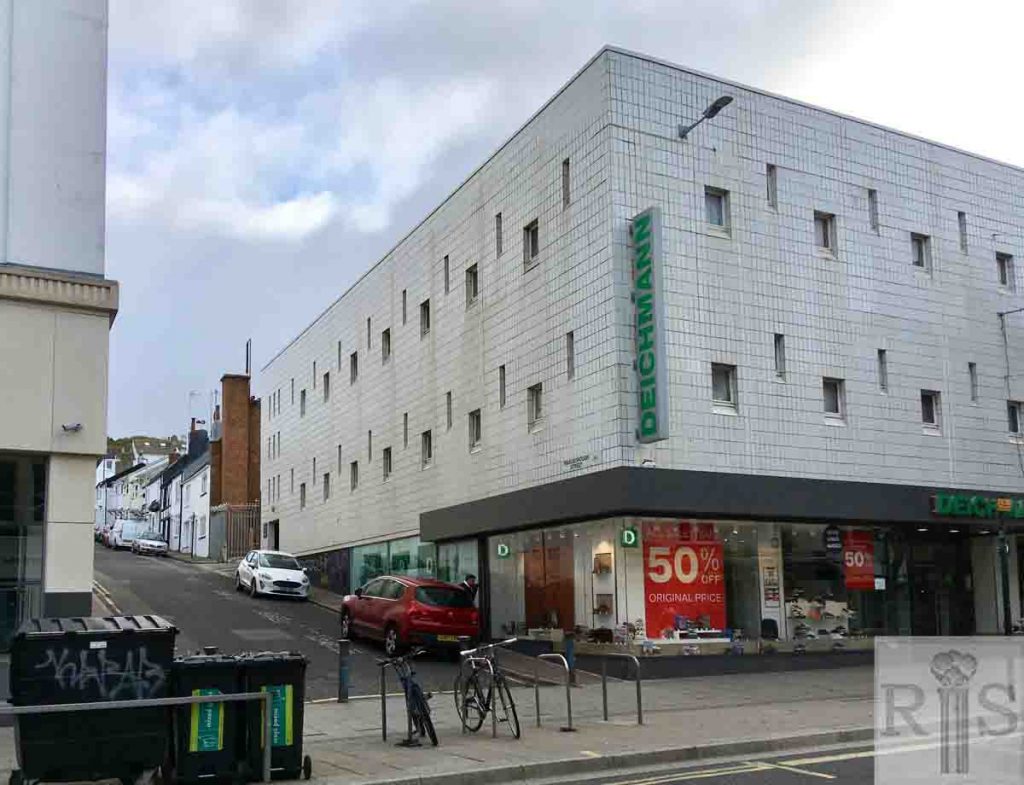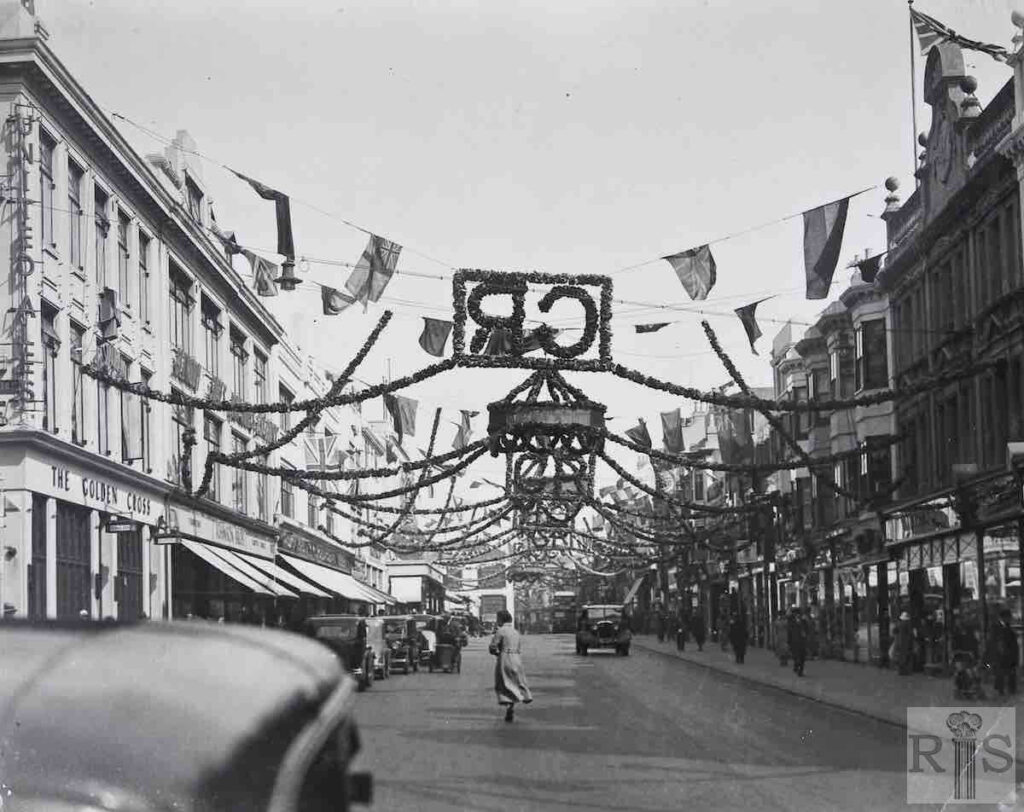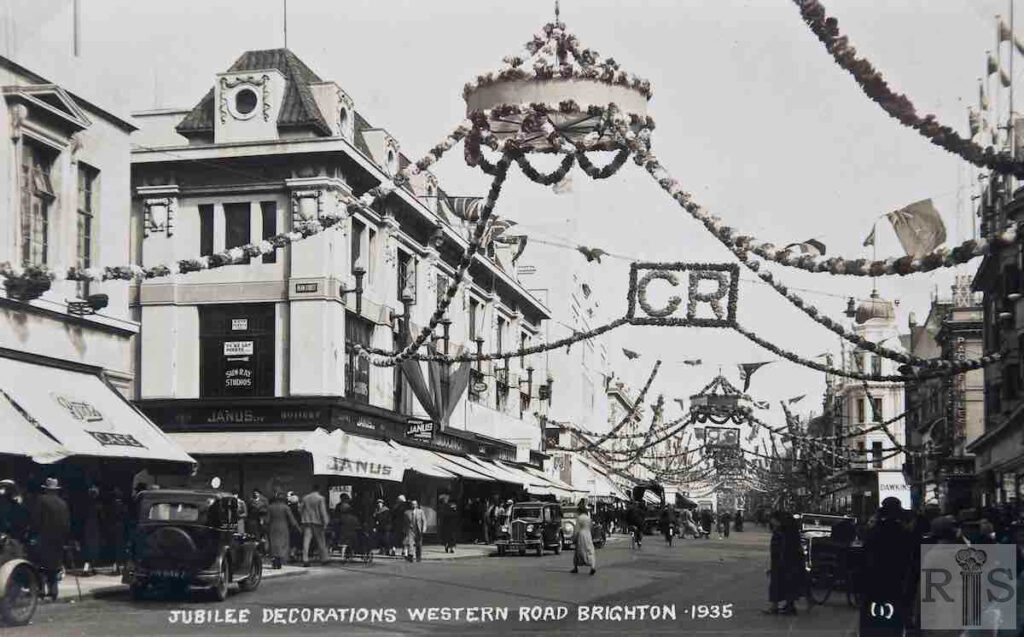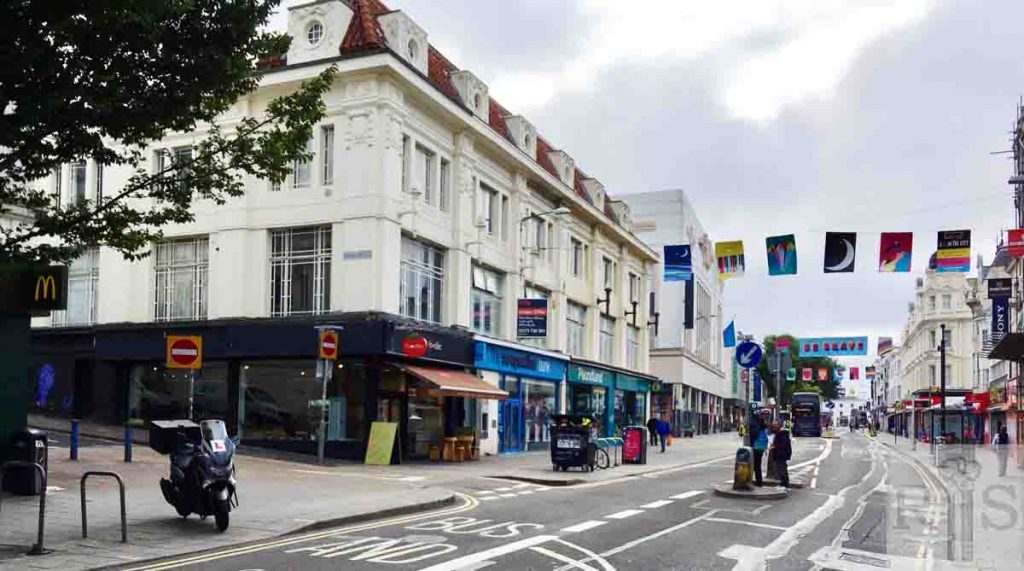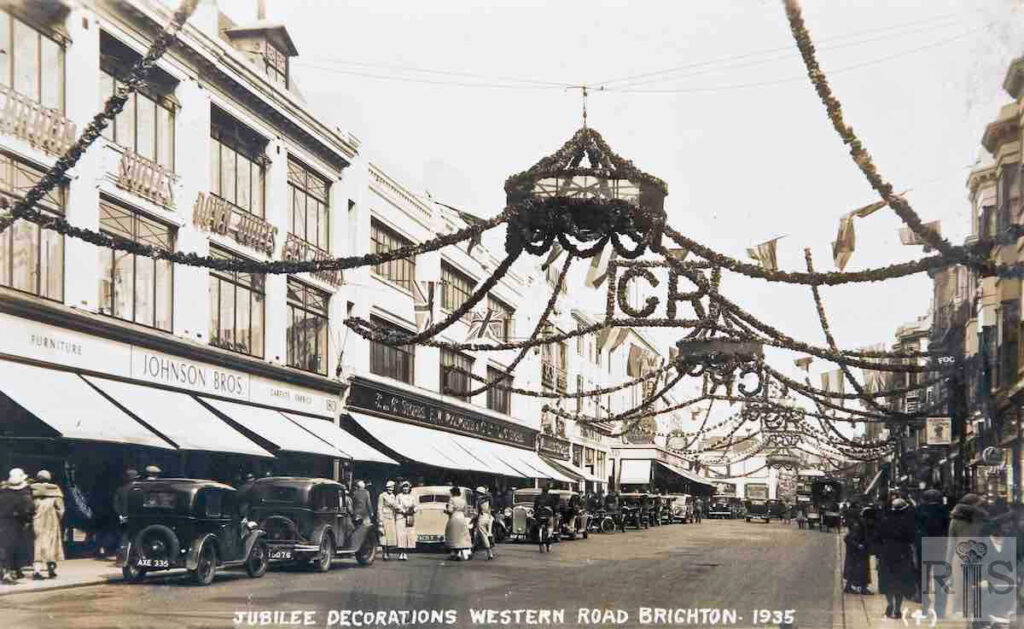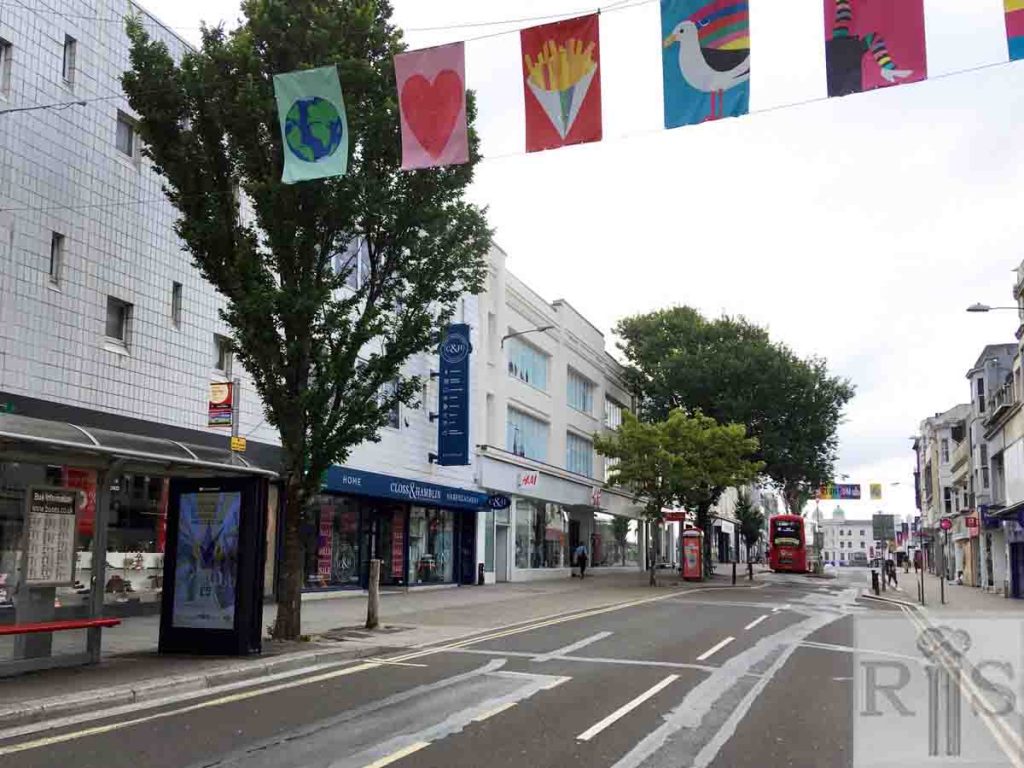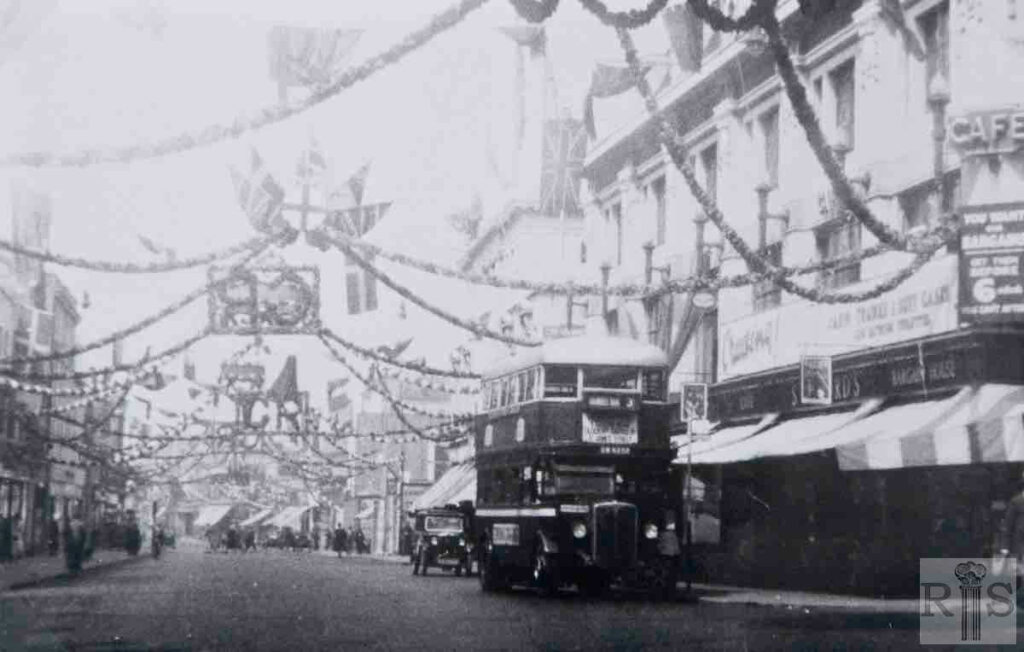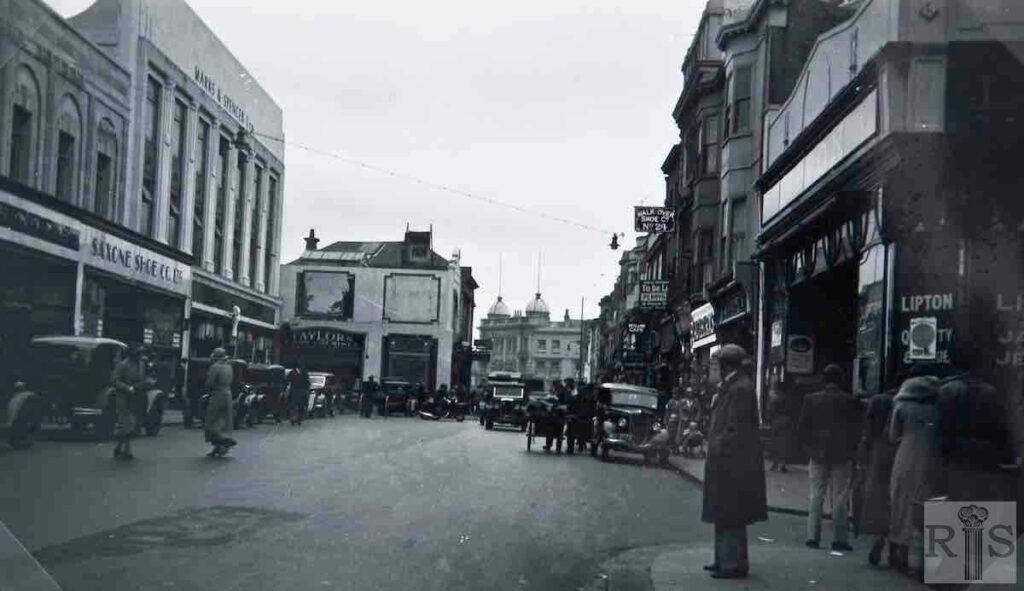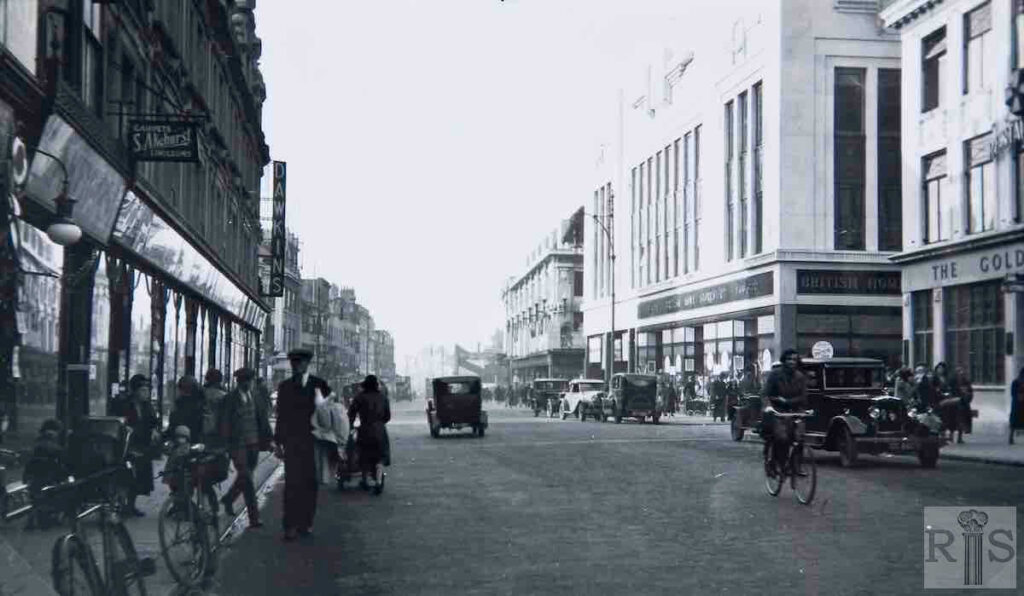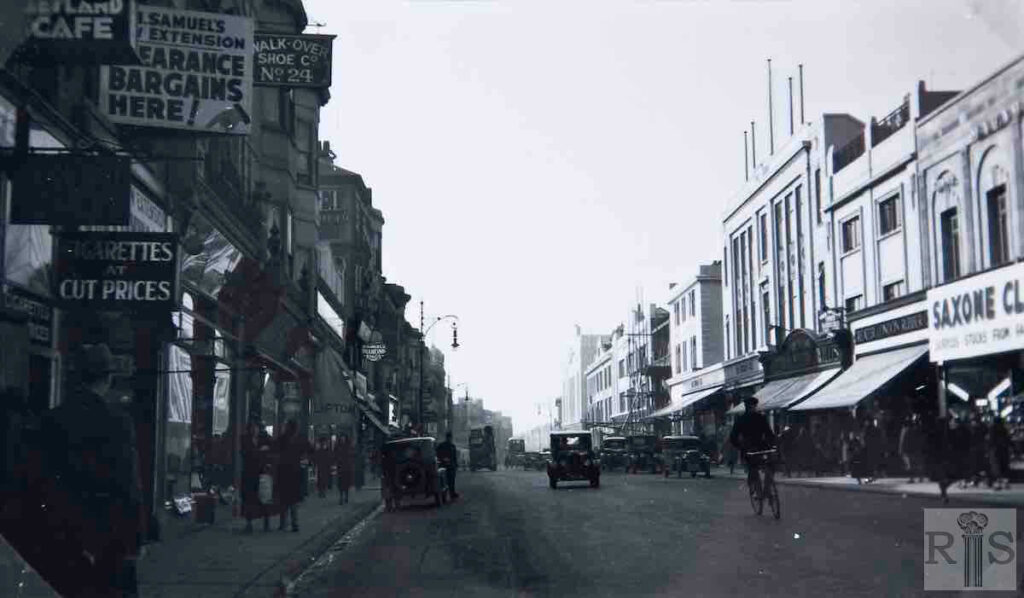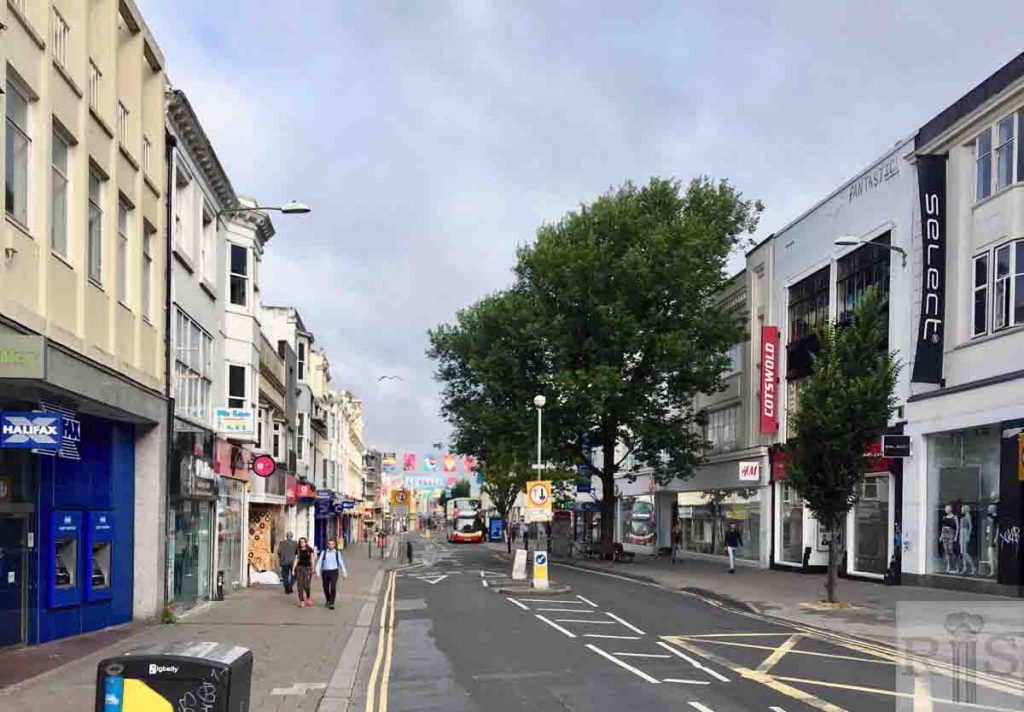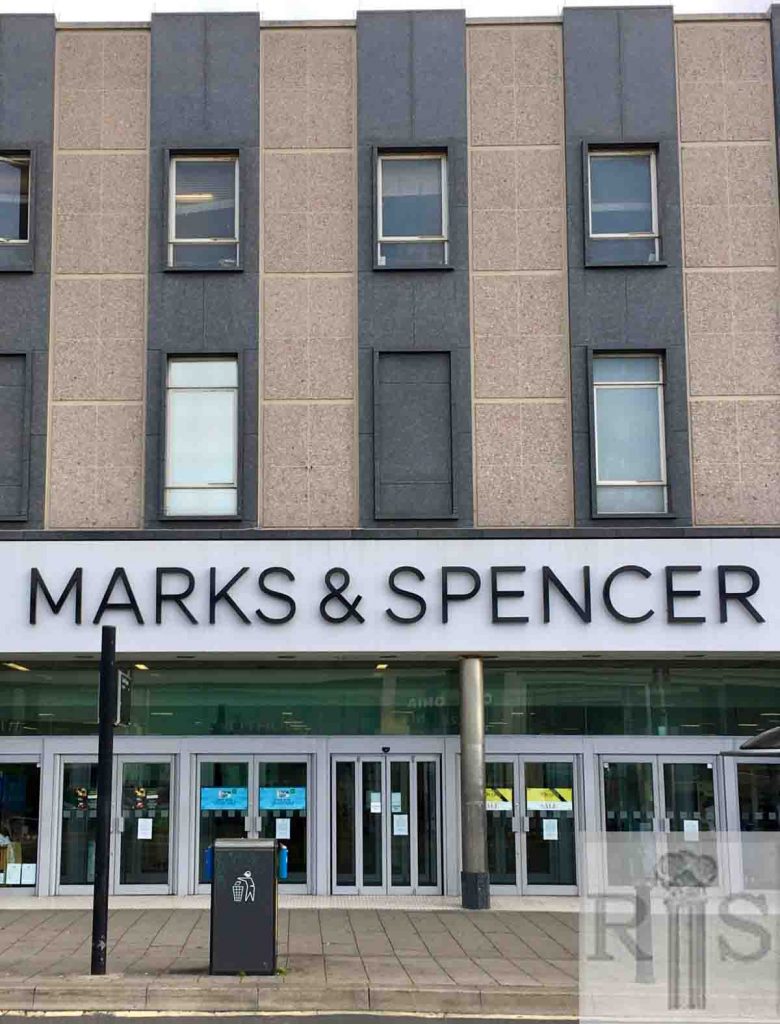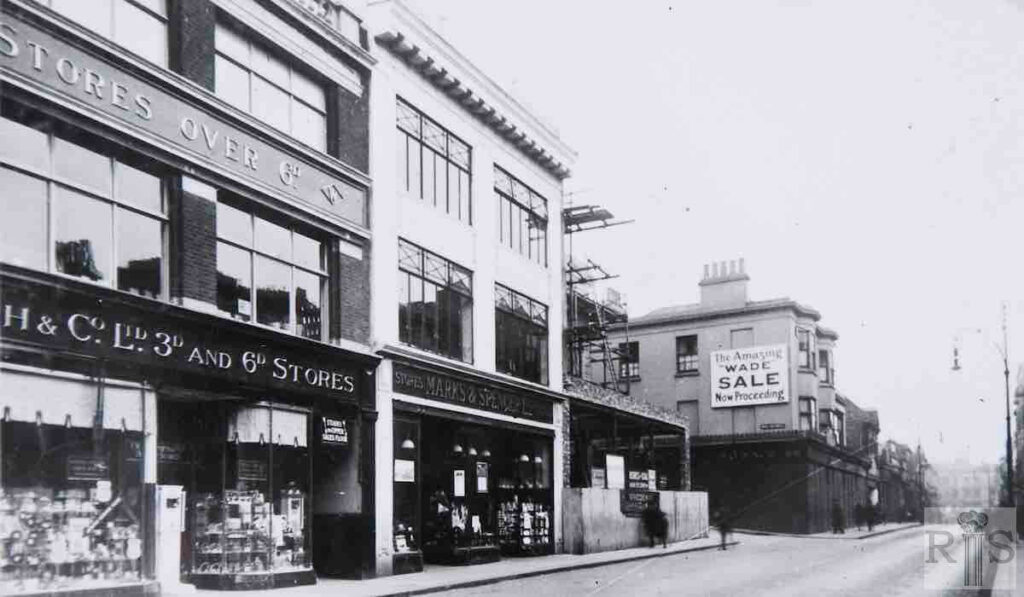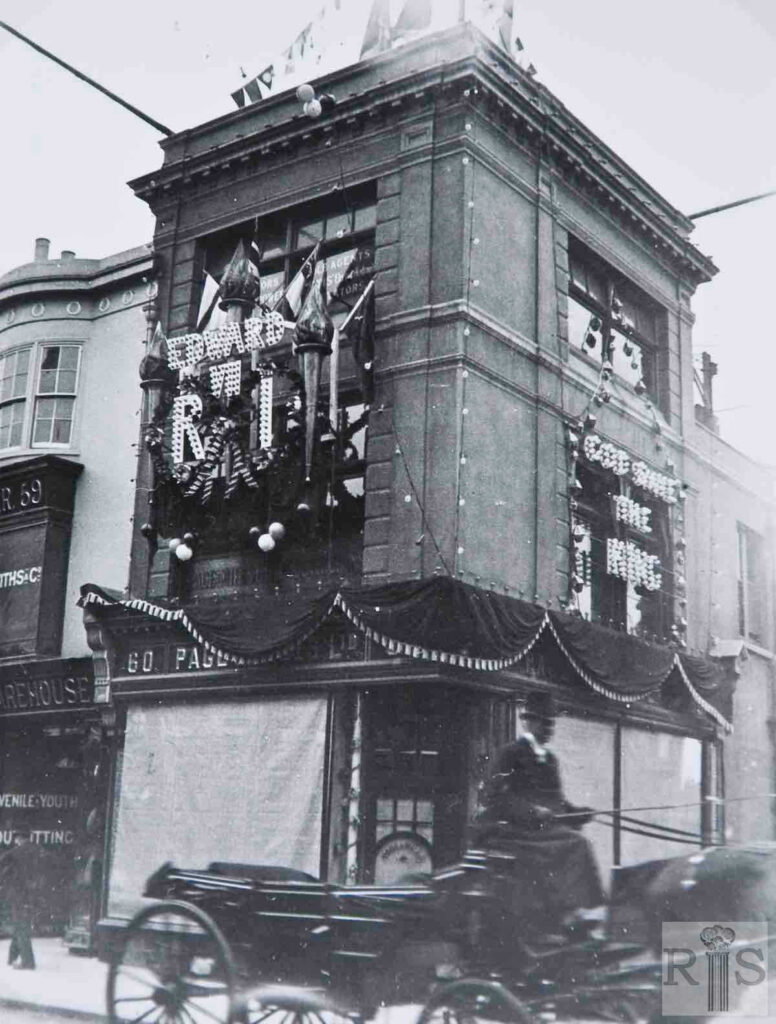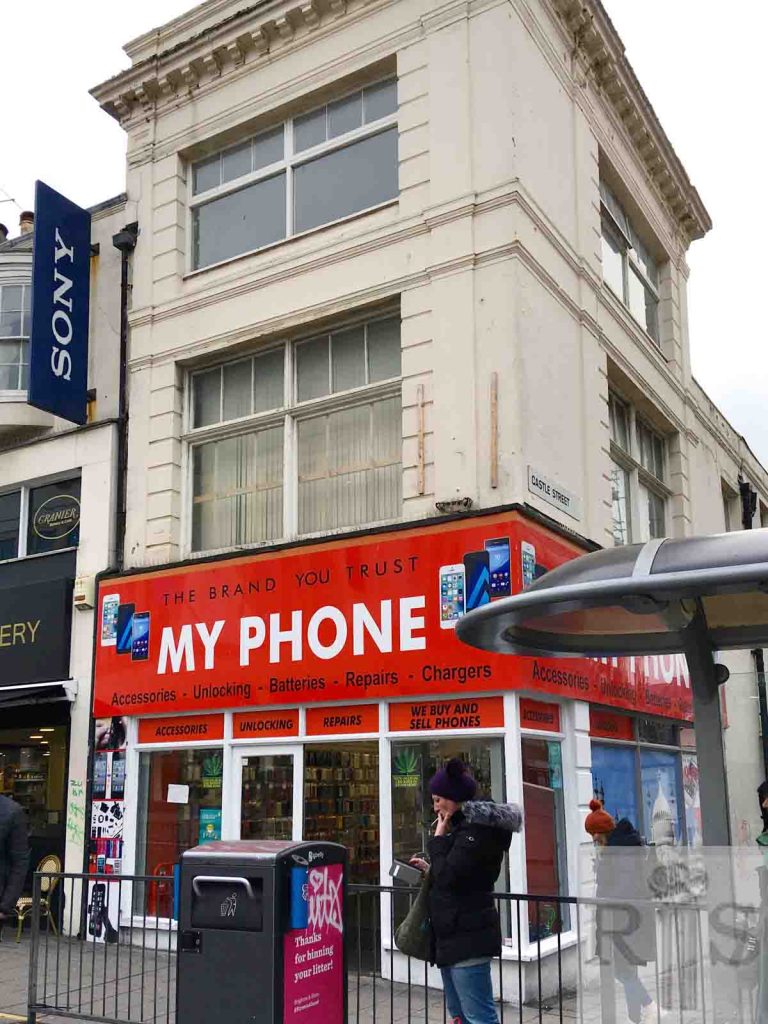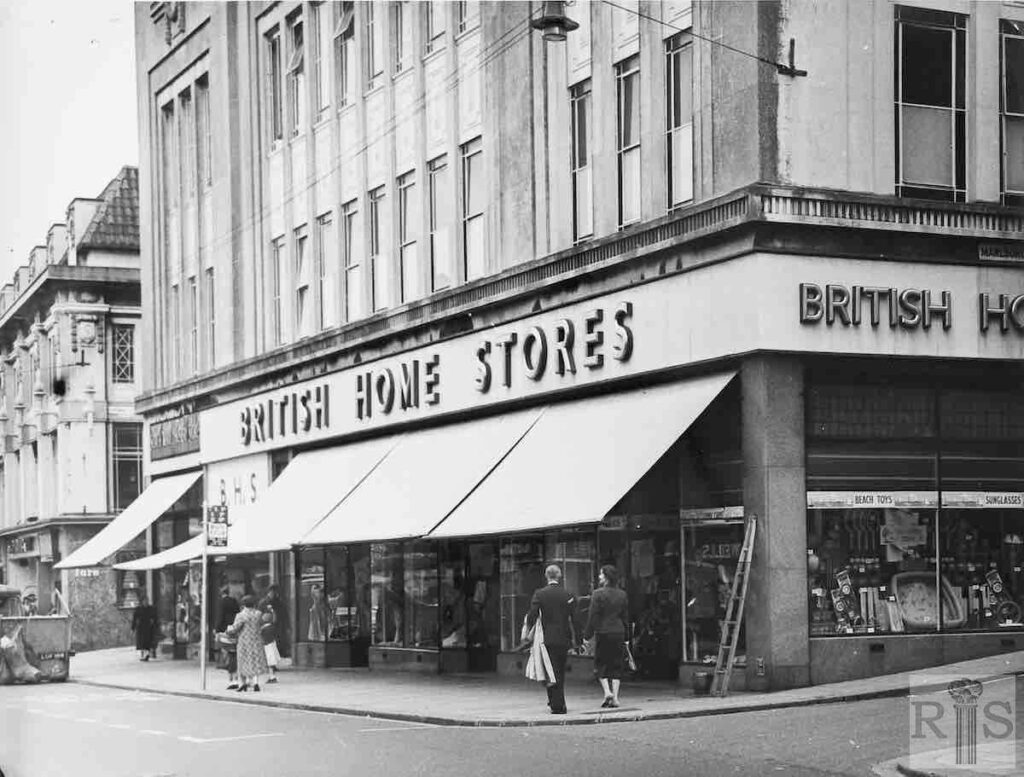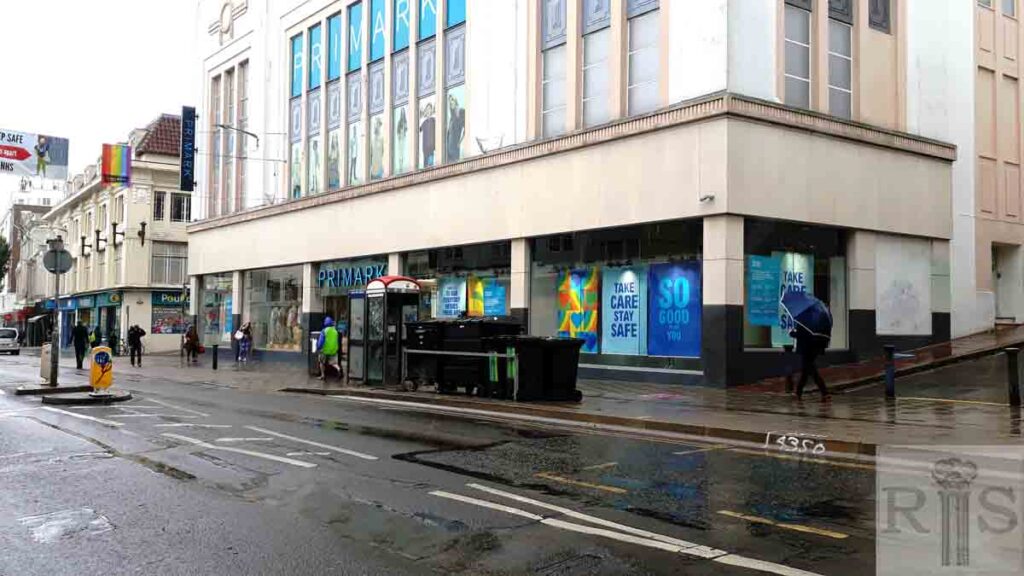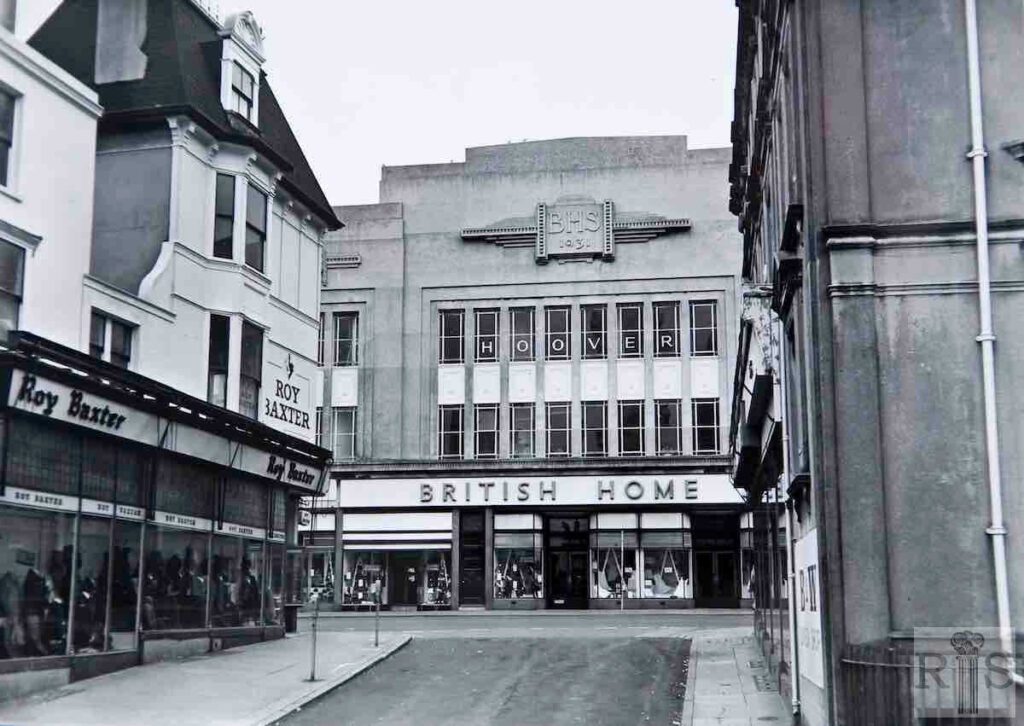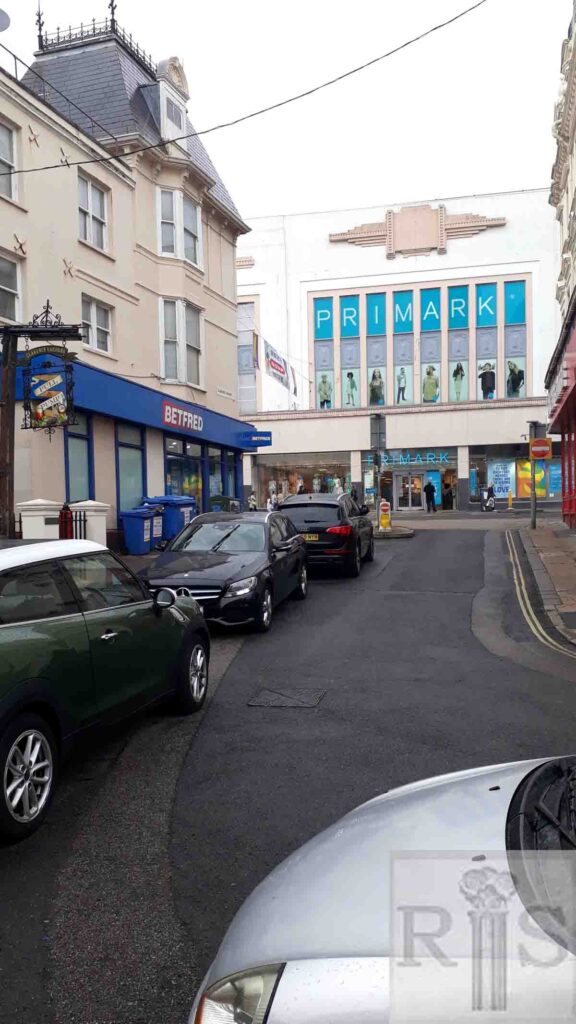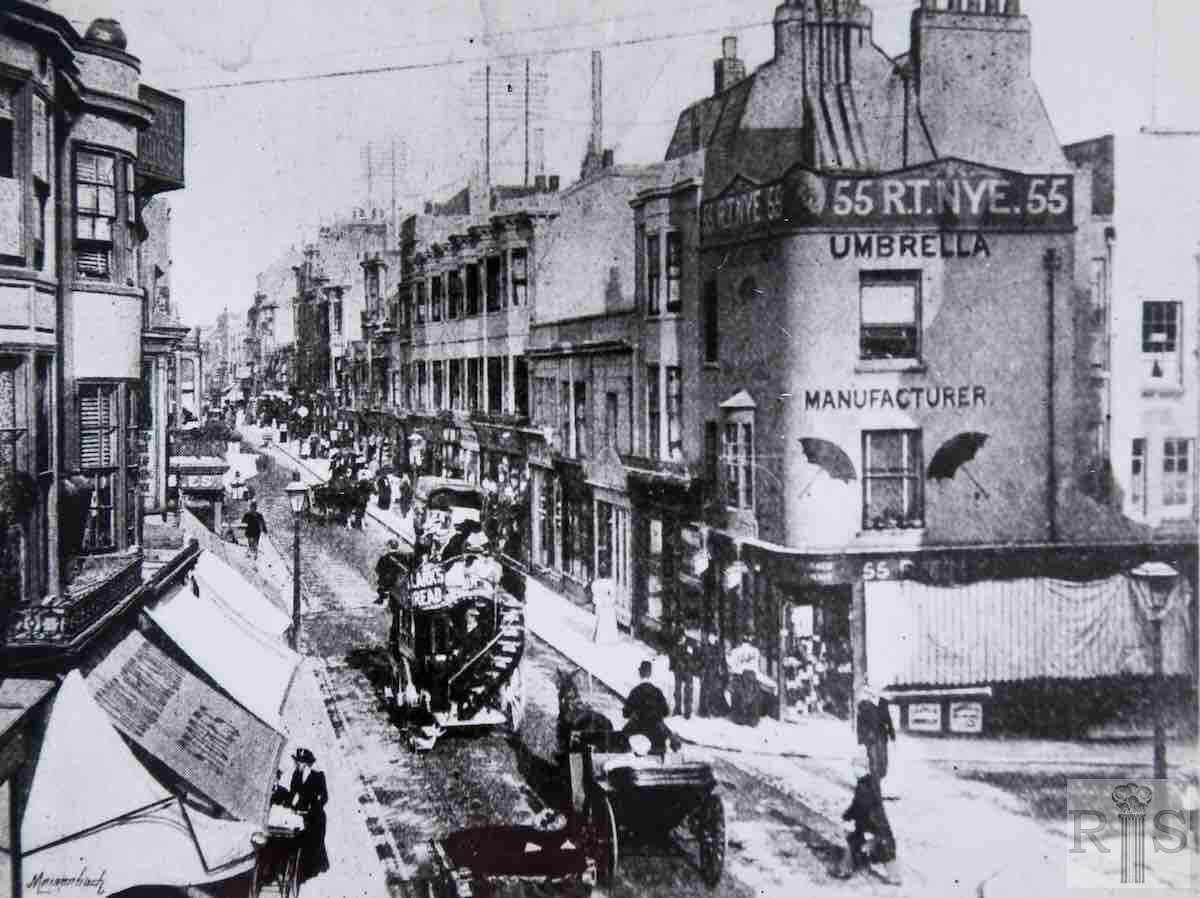
James Gray: THE METAMORPHOSIS OF WESTERN ROAD Probably the greatest change wrought to the face of Brighton during this century has been the rebuilding and widening of half the length of Brighton’s Western Road. The original north side of this road was a veritable hotch-potch of irregular buildings, many of which had been built as private houses, but had later suffered the indignity of having shop fronts built out over their front gardens. Numbers 144 to 148 were good examples of this.
James Gray: Western Road on a summer’s afternoon in 1910. Note the women’s fashions, the narrow road and absence of traffic. 41 years later, Mary Yorke’s shop is still at No 45. jgc_19_002
2019: Although the shop fronts have been much altered, it is still possible to detect the layout depicted in the 1910 photograph. A branch of the TSB bank now occupies 45-46 Western Road and Cancer Research UK, a charity retailer selling donated secondhand items, can be found at 43-44.
James Gray: The north side, between Crown Street and Marlborough Street, about the same period. Note Stafford’s original premises, where the rebuilding started in 1926. jgc_19_003
2019: The buildings at 169-174 Western Road between Crown Street and Marlborough Street shown in the 1910 image are no more, replaced in 1931 by the current building which originally housed the British Home Stores. When they moved to new premises in Churchill Square in the late 1960s, the building was taken over by C & A, a fashion retailer, but now houses a branch of the discount fashion chain Primark.
James Gray: Two photographs [see also jgc_19_024 below] of old Western Road, from Castle Street eastwards, in 1902 at the time of Edward VII’s Coronation. jgc_19_025
2019: The 1902 image shows Western Road at its junction to the south with Clarence Square where at no 55 R T Nye Umbrella Manufacturer traded from 1848 to 1903 (see jgc_19_034 below). Note the umbrella on the side of the building.
James Gray: In the year 1858 this low building was erected adjoining the Golden Cross Inn and was numbered 176 Western Road. Although hemmed in by taller buildings it remained in this form for nearly 70 years and for all that time it was occupied as a florist’s. It was demolished in 1927 for road widening and the site was used for the rebuilt Golden Cross, later Johnsons. jgc_19_026
2019: Deichmann, a trend-focused footwear chain, now occupies 175-178 Western Road at its junction with Marlborough Street in a block rebuilt in the early 1970s. Western Road from Hampton Place to the North Street junction was completely rebuilt to allow for road widening in the late 1920s and early 1930s.
James Gray: The view eastwards from the corner of Clarence Square, about 1900. Additional Information: R T Nye, Umbrella Manufacturer. jgc_19_034
2019: Western Road has been considerably widened since the original photograph was taken. See also caption for jgc_19_025. (Photographer: Nick Eastham)
James Gray: Carter Bros. shops at 172-173, between Crown Street and Marlborough Street, where the British Home Stores building is today. Carters were here from 1888 until 1917 when they moved to a shop at the corner of Dean Street, seen in another photograph [jgc_19_049]. Additional Information: Steam power bookbinders. jgc_19_043
2018: The buildings at 172-173 Western Road in the James Gray image were demolished when the road was widened in the late 1920s and early 1930s. The larger building that replaced them is now home to Primark. See also caption to jgc_19_003. (Photographer: Nick Eastham)
James Gray: This view is of the rebuilding of Boots during the winter of 1927. Additional Information: Stafford’s Bargain House. jgc_19_048
2018: The north (right-hand) side of Western Road remains at this point remarkably unchanged almost a century later. The Boots building being built in 1927 has obviously been finished and a number of different businesses have occupied the premises since Boots moved in the 1970s to the corner of North Street and Queen’s Road (see North Street (Brighton) (1) page). Stafford’s in the forefront on the right of the 1927 image is now home to the modern-day bargain house of Poundland. The distinctive lighting (flambeaux made locally in 1925 by H A Waller & Sons) has survived on the outside of the building. (Photographer: Nick Eastham)
James Gray: Above is Carters’ new premises at the corner of Dean Street in 1927. Note the protrusion of the opposite pavement where the roadway was still its old width. jgc_19_049
2018: The building is largely unchanged, particularly above street level. The corner site is currently occupied by Foodilic, a rustic, all-day cafe-eatery offering a healthy salad-oriented buffet. (Photographer: Nick Eastham)
James Gray: Carter Bros. stores at the corner of Dean Street and Western Road in the early 1920s. This was the third building to be demolished in the great Western Road widening. jgc_19_065
2019: Another large group of buildings which were demolished to permit road widening. This corner site is currently occupied by Foodilic. (Photographer: Simon Cooper)
James Gray: John E Stafford’s premises at the corner of Crown Street in 1896. (166-168 Western Road) This was the first building to be removed, in early 1926. Both these photographs show how the shops were built out over the gardens of the original private houses, seen in the background. jgc_19_066
2020: Over 100 years later, although the building in the original image has been demolished, the site is still occupied by the modern equivalent of John E Stafford’s Bazaar – Poundland. See also jgc_19_048 above. (Photographer: Simon Cooper)
James Gray: October 1928 Boots handsome new building is almost completed, and provides a distinct contrast with the adjoining temporary premises in the Bon Marché building. jgc_19_070
2020: The pedimented Boots building remains and has been home to a number of business over the years. The building in the forefront at the right of the 1928 image was replaced in 1931 by the building which currently houses Primark. Adjacent to Primark, where Stafford’s once traded, can now be found Poundland.
James Gray: A view of the ‘Dardenelles’ in the winter of 1929. It was so called because it remained a narrow stretch between two widened portions, and a great danger to traffic. This block of erstwhile private houses came down a year later when Mence Smith’s moved to their present location at the corner of Montpelier Road. The British Home Stores building was erected on this site in 1931. jgc_19_073
James Gray: Nos 175-182 Western Road, in December 1927. The photograph is interesting because it shows the effect of an earlier attempt at road widening, carried out between 1900-1910. Only a very short distance of roadway fronting Nos 179-185 was affected, and even this widening was considered insufficient when the new building line was established. Note the old Golden Cross public house, No 175, Johnson Bros.’ three shops, and the popular Cave’s Oriental Café. jgc_19_074
James Gray: These photographs [jgc_19_075 and 076] taken in 1923 show the demolition of buildings in Western Road, between Marlborough Street and Regent Hill. Here can be seen the original private houses, over the gardens of which had been built Victorian shop fronts. The bay fronted house was No 180, in front of which was the two storied shop of Messrs. Johnson Bros. The high wall on the right was the side wall of Cave’s Oriental Café, which remained in existence for a little longer. The present premises of Johnson Bros. replaced these old houses, built in the early 1820s, in 1929. jgc_19_075
2019: Closs & Hamblin now occupies 180 Western Road. See also caption for jgc_19_074 above. (Photographer: Denise Taylor)
James Gray: These photographs [jgc_19_075 and jgc_19_076] taken in 1923 show the demolition of buildings in Western Road, between Marlborough Street and Regent Hill. Here can be seen the original private houses, over the gardens of which had been built Victorian shop fronts. The bay fronted house was No 180, in front of which was the two storied shop of Messrs. Johnson Bros. The high wall on the right was the side wall of Cave’s Oriental Café, which remained in existence for a little longer. The present premises of Johnson Bros. replaced these old houses, built in the early 1820s, in 1929. jgc_19_076
2019: See caption above for jgc_19_075. (Photographer: Denise Taylor)
James Gray: Nos 175-180, the Golden Cross, and Johnson Bros. premises have been rebuilt and the new buildings can be seen peering behind Cave’s derelict café. Woolworths remain on the old building line. The last relic of the “Dardenelles” is represented by the forlorn lamp standard opposite the cleared site and seemingly in the middle of the roadway. jgc_19_079
2019: On the corner of Marlborough Street at No 175-178 is Deichmann shoes. At 179-180 is Closs & Hamblin haberdashery. This block was rebuilt a second time in the early 1970’s. The original 1928 and 1929 buildings were demolished after a serious fire. (Photographer: Denise Taylor)
James Gray: Marks and Spencer’s premises at 186 have been set back, but only to the intermediate building line established by the earlier widening. A few years later this new building had to be set back several feet to the new building line of the whole street. Brigdens new building, erected in 1928, had gone straight back to the new line, but had showrooms on the ground floor extending to the line of the other buildings. jgc_19_080
2020: Marks and Spencer’s, seen at the extreme right of the James Gray image, traded at 186 Western Road from 1912 to 1935 when it moved further east to 195-200 Western Road where it remains to this day, Next door to the left in the James Gray image is an early branch of Woolworths. Marks and Spencer has been replaced by Cotswold, an outdoor pursuits specialist, and Woolworths by H&M, a fashion retailer. (Photographer: Margaret Polmear)
James Gray: Mr T W Girling opened a cycle shop in 1886 at 156 Western road, at the corner of Spring Street and later, in 1895, moved to 185 seen above. Girlings later moved to Queens Road and Woolworths took over this shop in 1917. During the 1920s they also took over 183 and 184. In 1933 the roadway was set back by 10 feet and this old building was demolished. jgc_19_046
James Gray: Woolworths has been rebuilt and the adjacent new building, recently vacated by Marks and Spencer, has been set back several feet. Brigden’s have lost their projecting showrooms, enabling the roadway to be widened throughout the block. The large new building, covering the whole of the previous block, which was erected in 1931, is now seen for the first time. Four consecutive blocks, from Spring Street to Regent Hill, have now been completed. jgc_19_081
2019: Select Fashion now trades at 187 Western Road at what was Brigden’s. The front of the old store was demolished and taken back to what is now the front line of Western Road during road widening between 1926 and 1936. Cotswold, an outdoor clothes and equipment specialist, is currently at 186 Western Road, previously the home of Marks and Spencer. Numbers 181-185 Western Road were rebuilt for Woolworths in 1931. The company traded at this address until it went out of business in 2008. It is now occupied by H & M, a fashion retailer. (Photographer: Denise Taylor)
James Gray: Probably the narrowest part of old Western Road was that short strip between Johnson’s and Clarence Square. Here the road narrowed so acutely that these few yards were nicknamed the Dawkins Dardanelles. During the 1920s Western Road was paved with wood blocks. Lewes Old Bank was at 178 Western Road from 1898-1927. jgc_19_082
2019: The James Gray image of 1933 shows nos 169-187 on the northern side of Western Road. Nos 169-180 are now hidden by trees but from west to east currently house Primark, a discount fashion store, Deichmann, a shoe retailer, and Closs & Hamblin, formerly called C&H Fabrics. Continuing eastwards can now be found H&M, another fashion store, Cotswold, an outdoor pursuits specialist, and, on the site that was Brigden’s, Select Fashion which requires no description.
James Gray: This photograph was taken in 1924 and shows the old and new types of motor bus. That facing the camera was wider and considered a great improvement on the earlier one. jgc_19_083
2020: Also prominent in the James Gray image is Lewes Old Bank at 178 Western Road. The bank was established in 1789 (note the stone set into the balustrade) and enjoyed the longest independent life of any of the early private banks in Sussex, merging with eighteen other private banks to form Barclays Bank Ltd in 1896 (note wording below the balustrade). Lewes Old Bank was built over the front garden of a private house in the 1890s and remained at 178 Western Road until 1925. The building was demolished with much else in the vicinity shortly afterwards and the address is now home to Deichmann, a shoe retailer, in a block rebuilt in the early 1970s. See jgc_19_002 for an image of Mary Yorke’s seen on the extreme left of the James Gray photograph. (Photographer: Margaret Polmear)
James Gray: Another view. jgc_19_084
2019: The 1927 image shows to the north (right hand side) 178-185 Western Road with Lewes Old Bank (see jgc_19_083 above) jutting out into the narrowest section of the road and the Woolworths building in the forefront with a rather splendid car parked outside. This was one of the earliest F W Woolworth stores. It opened on 5 August 1916 and closed only when the company went out of business on 30 December 2008. The site is now occupied by H&M, a fashion retailer. In the forefront of the southern side of both images is 38-39 Western Road. The premises merged around 1913 and from 1991 to 2009 were occupied by a branch of the Abbey National Building Society and thereafter and until 2015 by a branch of the Santander Bank. The site has been vacant since. (Photographer: Denise Taylor)
James Gray: This old photograph is of the old Golden Cross Inn at the corner of Marlborough Street. Built in the 1830s as a private house, and known for some years as 163 Western Road, it became an inn in 1854. It was demolished with adjoining properties in 1928. jgc_19_085
2019: Diechmann, a shoe retailer, now occupies the site of the former Golden Cross. See also captions for jgc_19_026, 074 and 086. (Photographer: Denise Taylor)
James Gray: The new inn, 28 years later. No fewer than eight houses on the east side of Marlborough Street were demolished with the old Golden Cross. The brewers have now sold the premises to Johnson Bros. for an extension to their store and soon the sign of the Golden Cross will leave Western Road forever. jgc_19_086 and jgc_19_087
2019: The current building on the site of the former Golden Cross dates from November 1971. From 1981-2015 it was occupied by Topshop, a fashion retailer, and since 2015 has been home to Deichmann, a shoe company. See also captions for jgc_19_026, 074 and 085. (Photographer: Denise Taylor)
James Gray: East from Marlborough Street with Western Road bedecked – May 1935. King George V Silver Jubilee celebrations. jgc_19_088
2019: Looking east towards the corner of Marlborough Street. Traffic calming measures prohibit general traffic from Western Road nowadays so only buses and taxis are allowed to enter. (Photographer: Denise Taylor)
James Gray: The decorations to mark the Silver Jubilee Celebrations of King George V and Queen Mary, May 1935. jgc_19_089
2019: The junction of Western Road and Dean Street is remarkably unchanged. The eastern corner is now occupied by Foodilic, a vegetarian/vegan restaurant. The western corner opposite is home to McDonalds, a fast-food burger establishment. Note the trademark M on the extreme left of the image. Western Road is still often bedecked with decorations of one sort or another but nothing on the scale of those for the 1935 Silver Jubilee. (Photographer: Denise Taylor)
James Gray: The decorations to mark the Silver Jubilee Celebrations of King George V and Queen Mary, May 1935. jgc_19_090
2019: This stretch of Western Road showing principally nos 175-185, unlike that in jgc_19_089 above, is much changed and is now home to Deichmann, a shoe retailer, Closs & Hamblin, formerly C&H Fabrics, and H&M, a fashion retailer. The road in 1935 is more choked with traffic than in 2019. Perhaps this is the result of the Silver Jubilee decorations. (Photographer: Denise Taylor)
James Gray: The partly widened Western Road gaily decorated for the Silver Jubilee of King George V, in May 1935. The bus is standing outside Stafford’s, at the corner of Crown Street. jgc_19_155
James Gray: View eastwards from Clarence Street, showing the old and the new Western Road. It can be seen that the old roadway was little more than half the width of the new. It is hard to date this photograph. Most likely it was in the winter of 1934-35. jgc_19_156
James Gray: Rebuilding the old Marks and Spencer store between Woolworths and Brigden’s. jgc_19_092
2019: Marks and Spencer traded at 186 Western Road from 1912 until 1935 when it moved further east to 195-200 Western Road where it remains to this day. 186 Western Road is now occupied by Cotswold. H&M currently trades on the Woolworths site and Select Fashion where Brigden’s once stood. See also caption for jgc_19_082 above. (Photographer: Denise Taylor)
James Gray: Dann’s Creamery, 200 Western Road in 1897. Another of the business premises built in the garden of a private house. It enjoyed the distinction of being the last building to be destroyed in the Western Road widening. When this took place, in 1936, the building was occupied by Taylors Cash Chemists. jgc_19_093
2019: 200 Western Road now houses Marks & Spencer. From 1885 Dann’s Creamery Store traded there until 1918. Between 1926 and 1936 part of the widening of Western Road involved the demolition of the south side of the Imperial Arcade. No 200 had the distinction of sticking out into Western Road until as late as George V’s Silver Jubilee in May 1935. Soon after that it was the last old building to be razed. (Photographer: Denise Taylor)
James Gray: February 1928. Looking down the narrows of old Western Road from the original Wade’s shop to the Clock Tower. Till now no rebuilding had taken place in this block but in 1929 Wade’s moved to the Bon Marché premises and a start was made with their new building. In the foreground are Woolworths original store, the new building next door destined to be set back still further in only four years time, and Brigden’s new premises wisely set back to the new building line. Incidentally, where was all the traffic in those far off days? jgc_19_100
2020: This section of the northern side of Western Road has been completely rebuilt. H&M now occupies the site where Woolworths traded and Cotswold that of the former Marks & Spencer building. The latest replacement for Brigden’s was Esprit, another fashion retailer, but the premises are now empty, a casualty perhaps of the current coronavirus pandemic. At the eastern junction of Western Road and Regent Hill, where Wade’s traded from 1892, can be found New Look, yet another fashion retailer. See also caption for jgc_19_082. (Photographer: Margaret Polmear)
James Gray: Two photographs of old Western Road [see also jgc_19_025 above], from Castle Street eastwards, in 1902 at the time of Edward VII Coronation. jgc_19_024
2019: This image is taken from Western Road looking at the south-east corner of Castle Street. 60 Western Road is occupied by My Phone and Nos 58-59 are Granier Bakery Café. In the old image at No 60 were Page and Miles Electrical Engineers and Contractors who were in the premises from 1891 for 56 years. Next door at No 59 was F W Griffiths & Co. Juvenile Outfitters. (Photographer: Denise Taylor)
James Gray: As can be seen, this building was erected in 1931 and was occupied continuously from that year until 1969 by British Home Stores. When the stores moved to new premises in Churchill Square, the building was reconstructed for occupation by C&A Modes whose store was opened in 1970. Additional Information: Now, 2008, Primark. jgc_19_105
2020: In 2001 C&A Modes moved out of the UK and Littlewoods bought 169-174 for the retail arm of its business. In 2005 Littlewoods was sold to Associated British Foods, which owned Primark (fashion).
James Gray: As can be seen, this building was erected in 1931 and was occupied continuously from that year until 1969 by British Home Stores. When the stores moved to new premises in Churchill Square, the building was reconstructed for occupation by C&A Modes whose store was opened in 1970. This view taken December 8 1968. Additional Information: Now, 2008, Primark. jgc_19_106
2020: See also jgc_19_105. In 2020, Nos 169-174 looks exactly the same from Clarence Square as it did in 1968, apart from the blank cartouche which used to read ‘BHS 1931’. Roy Baxter Men’s Shop at 81-2 Western Road has been replaced by Betfred, with an infill extension at first floor level in Clarence Square. The 2020 image had to be taken from a slightly different position to that from which the 1968 image was taken to avoid a parked car. This is why the sign for the Pull and Pump pub can be seen. (Photographer: Jane Southern)
